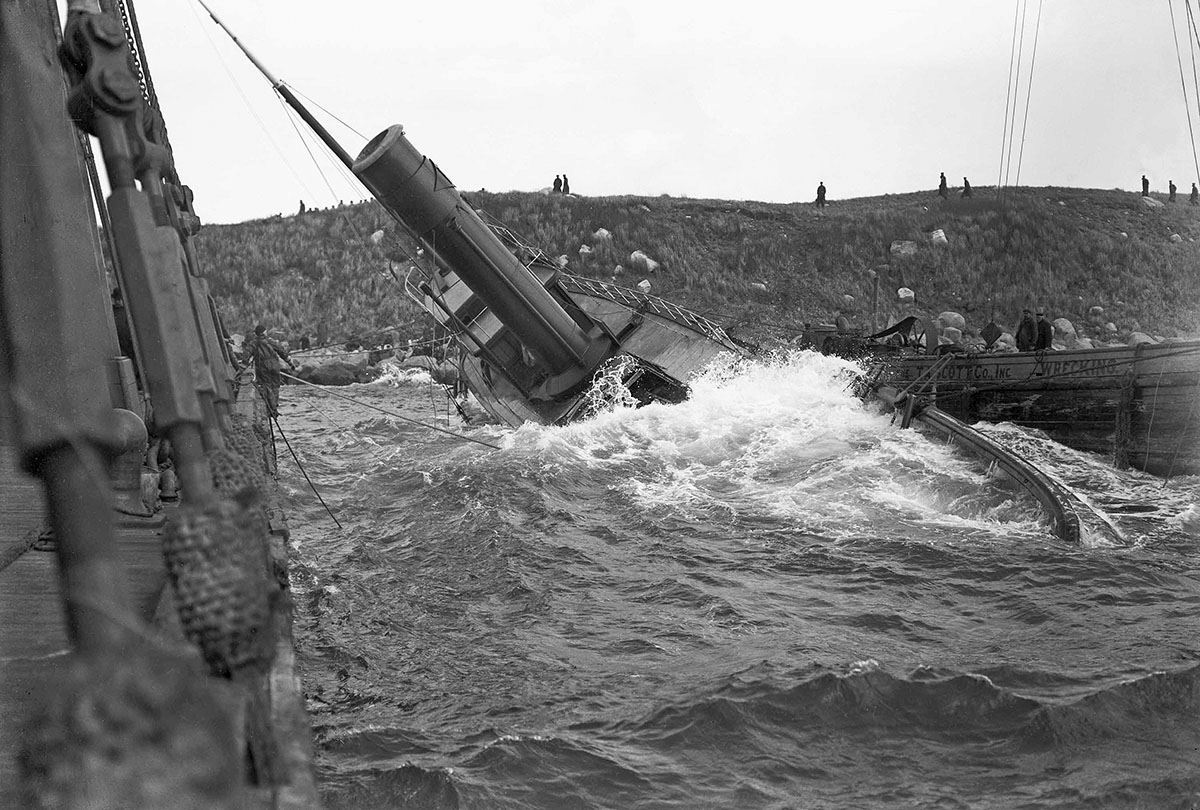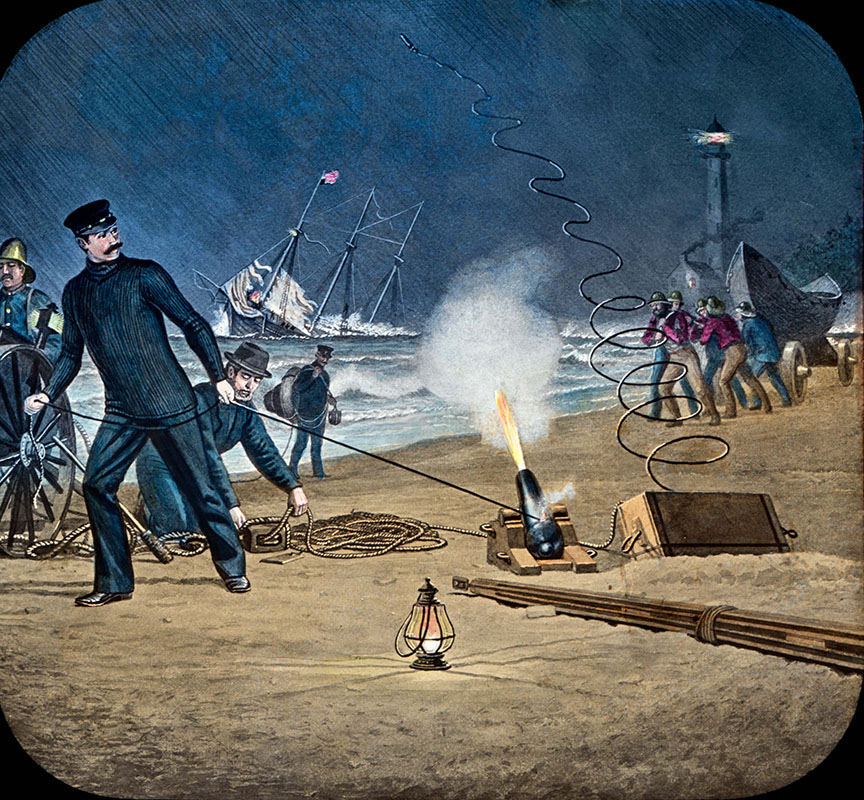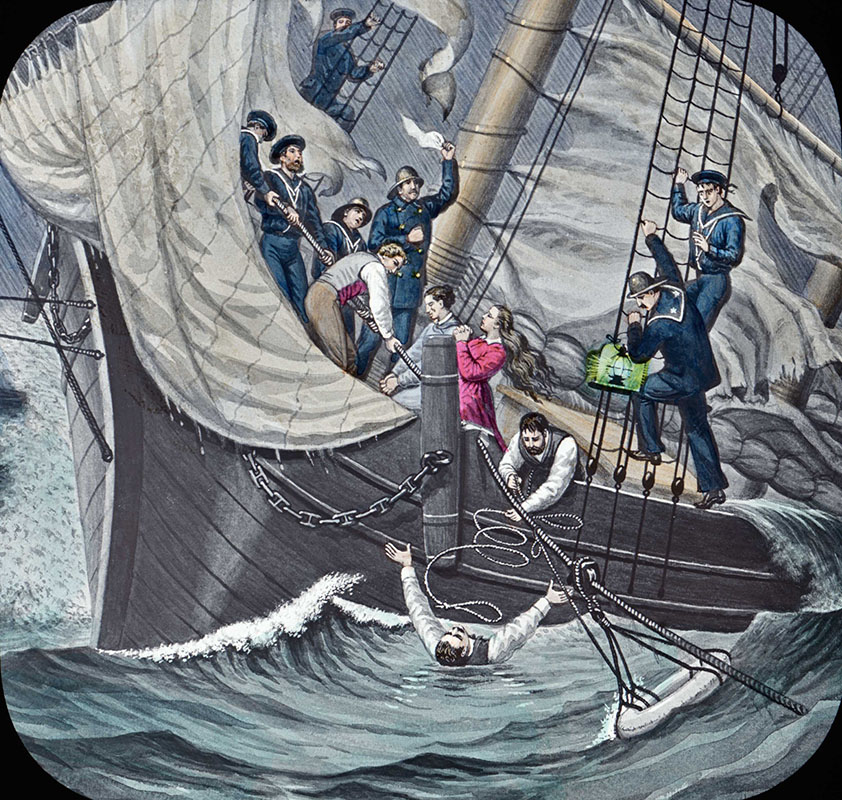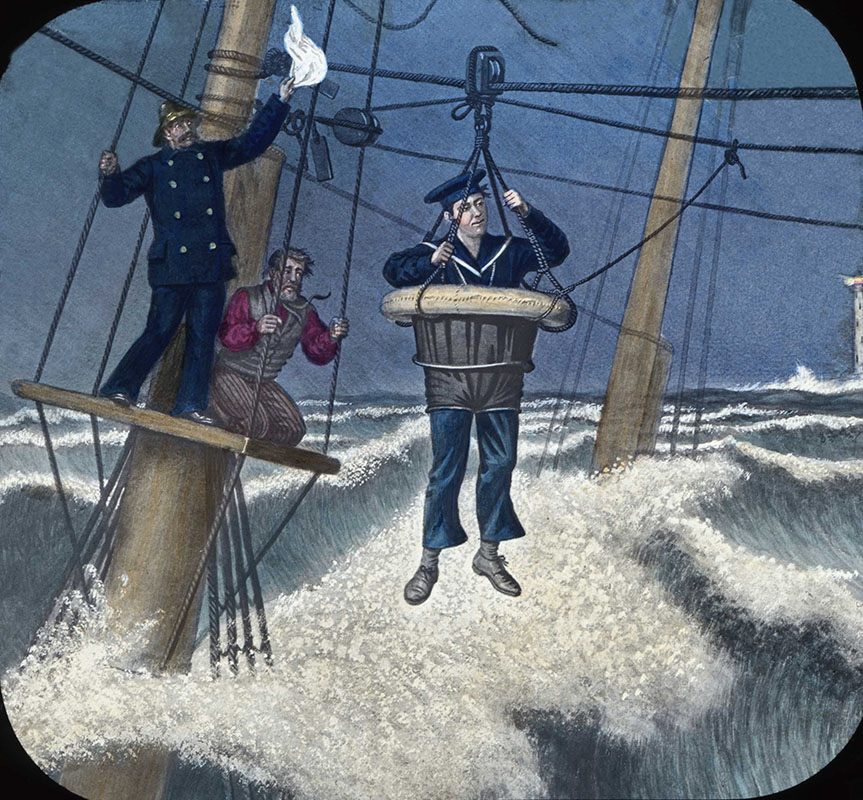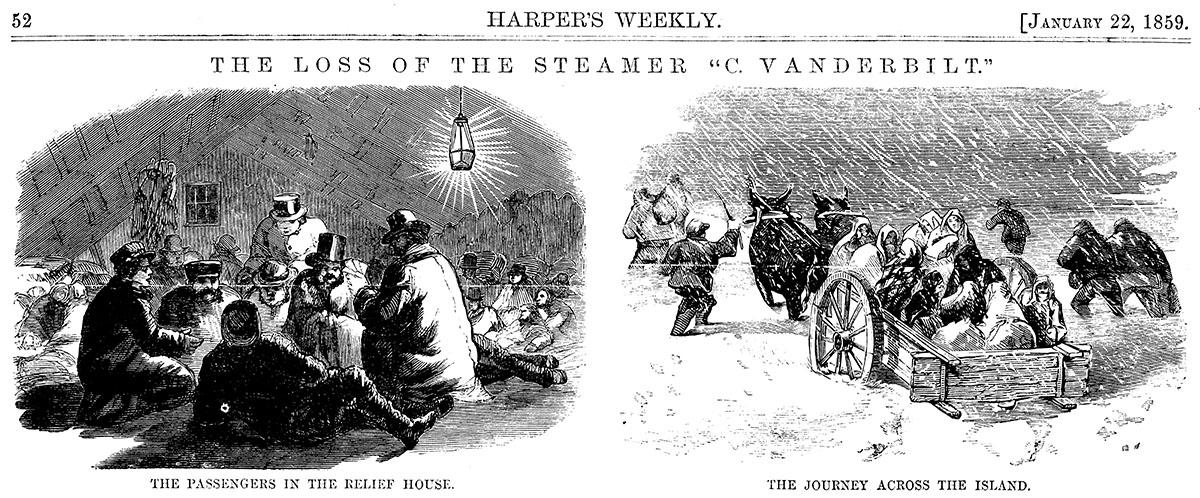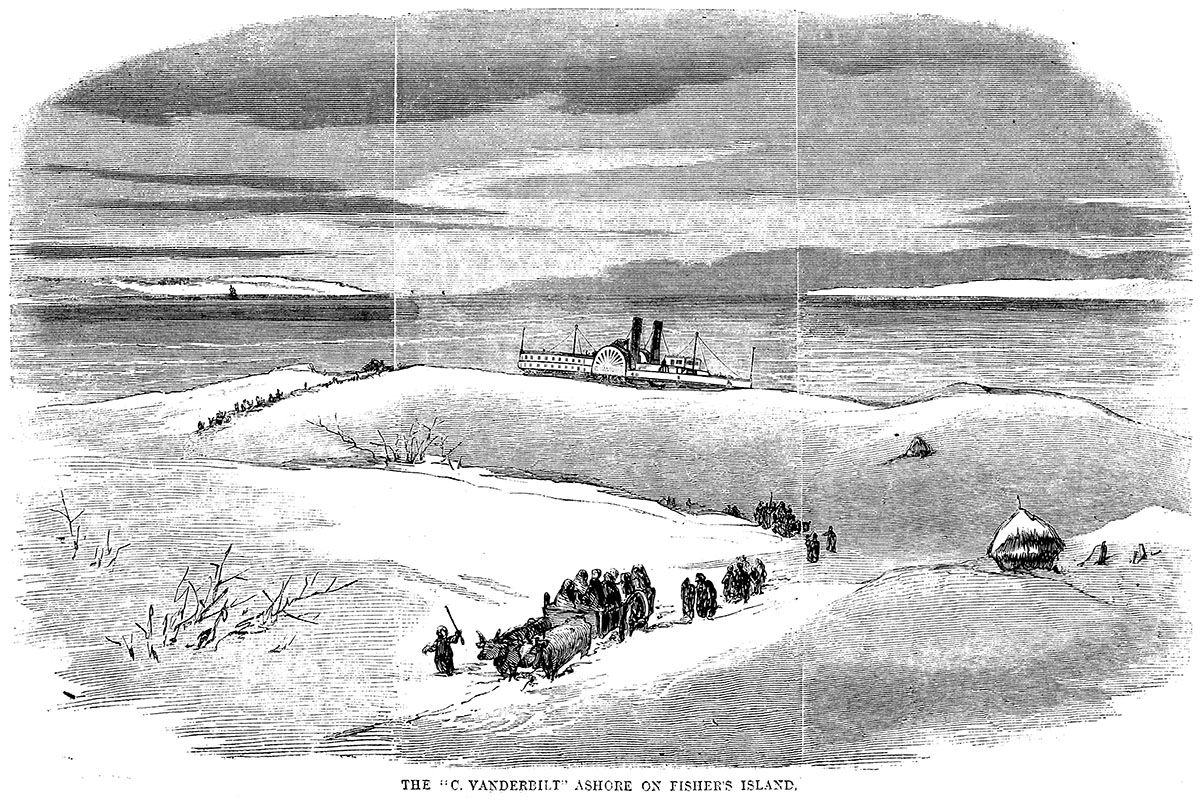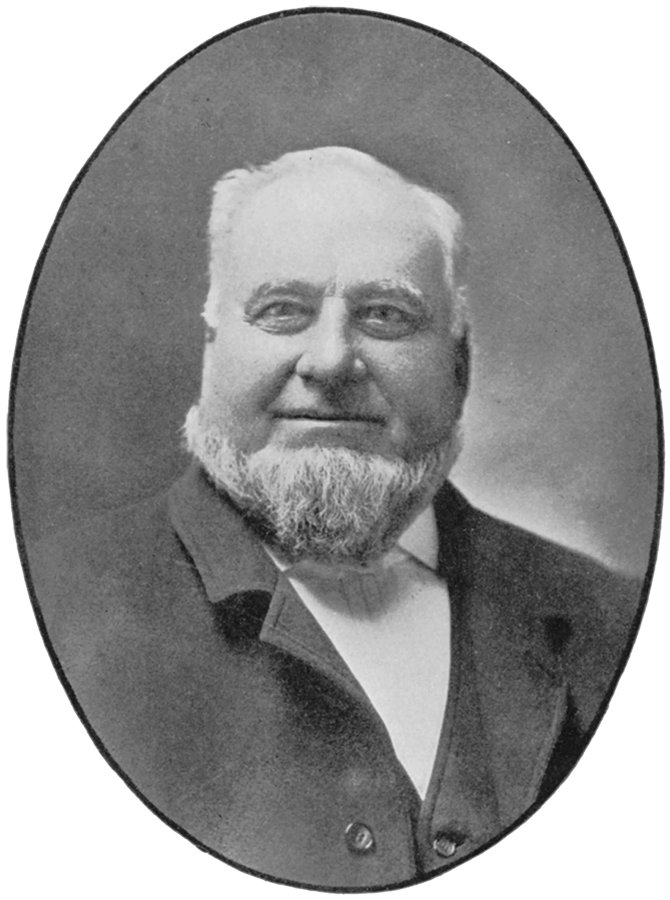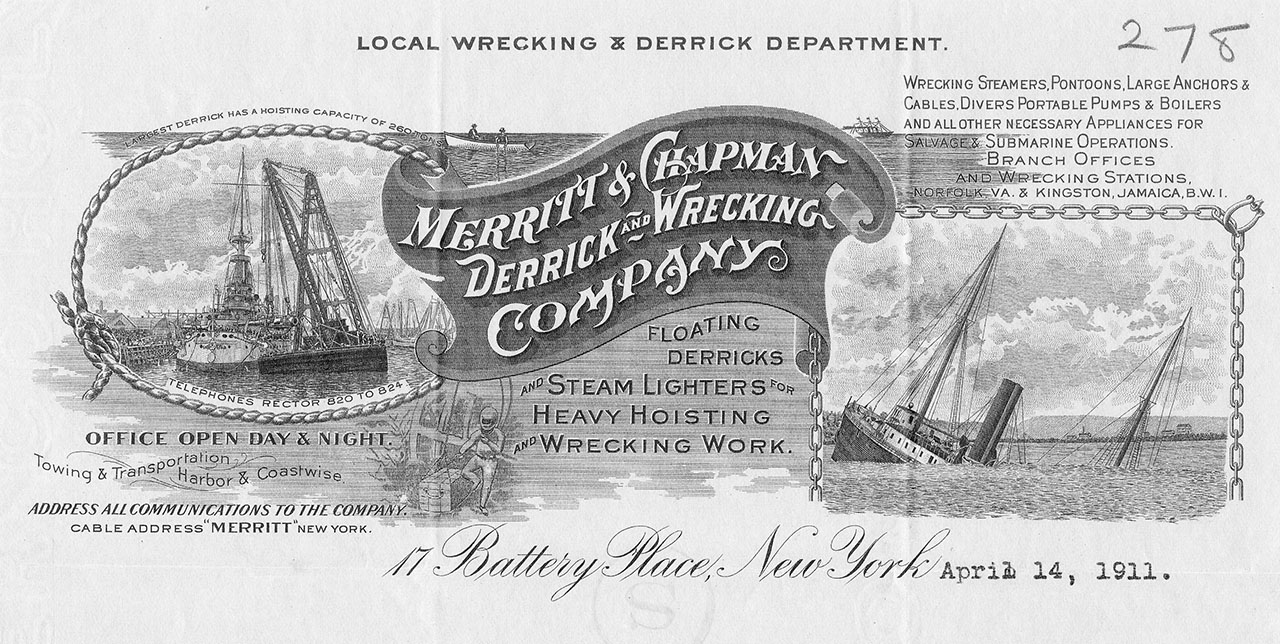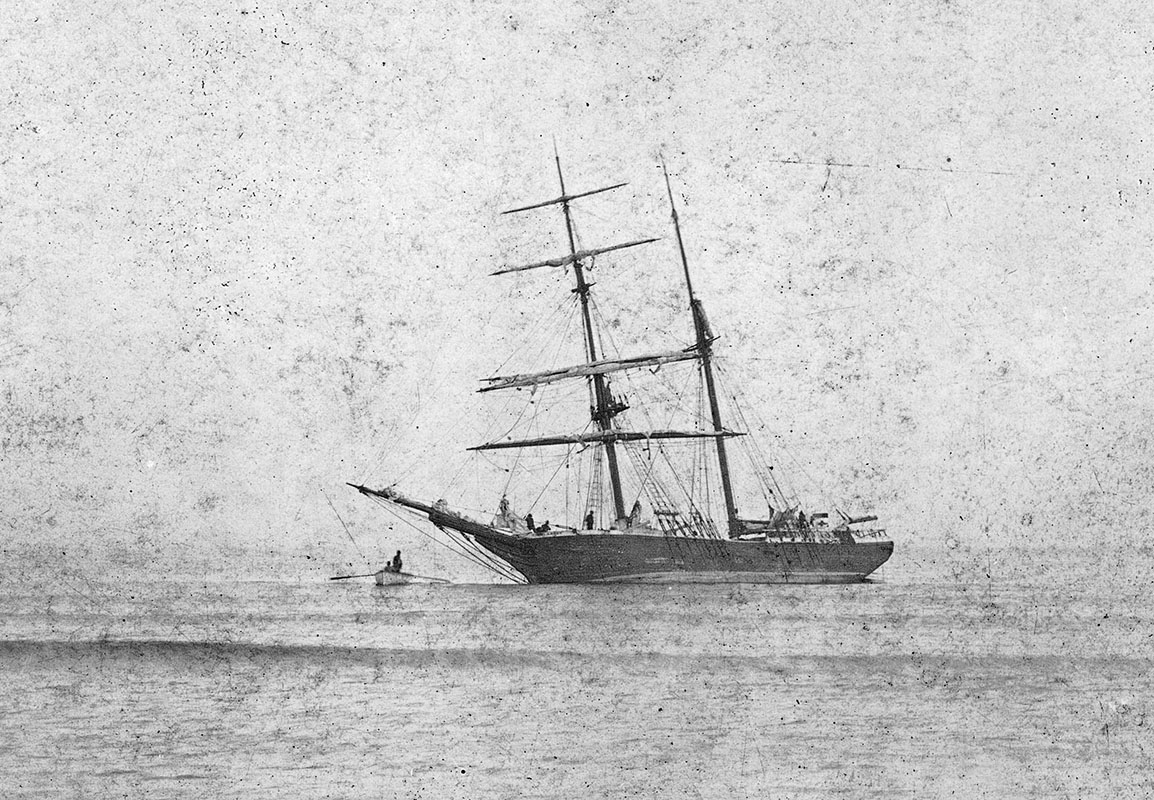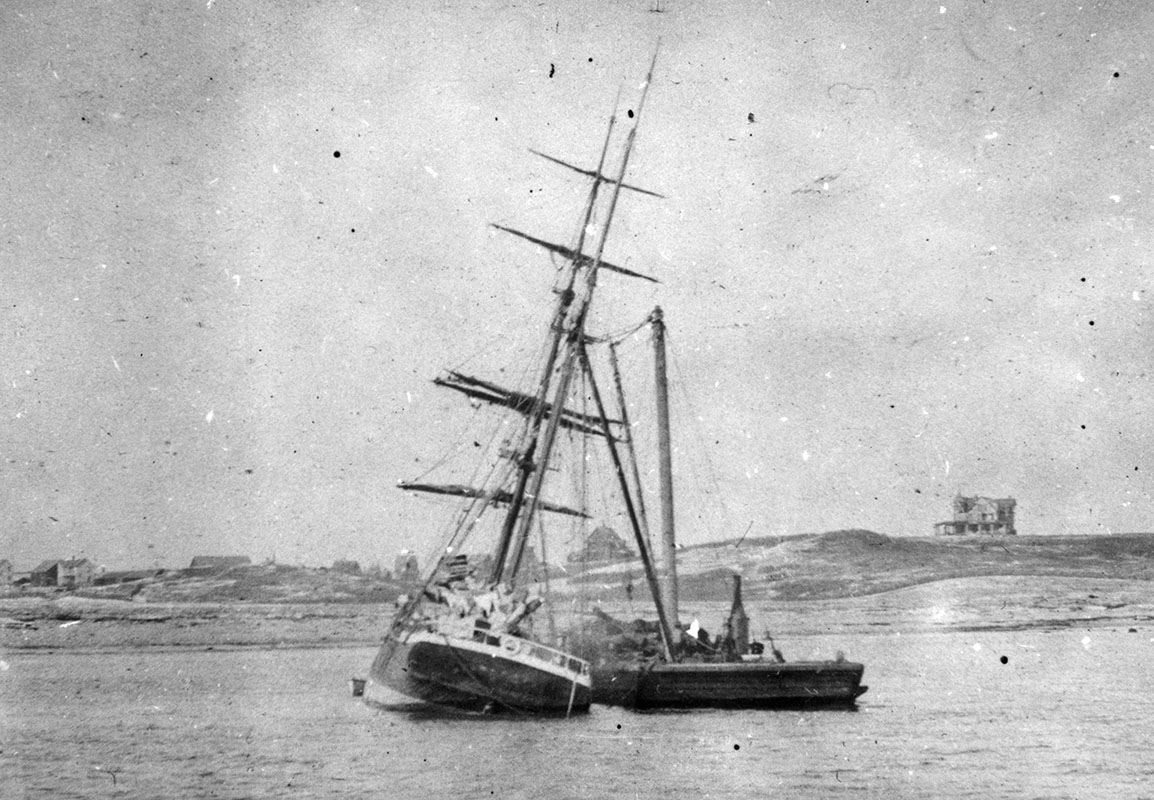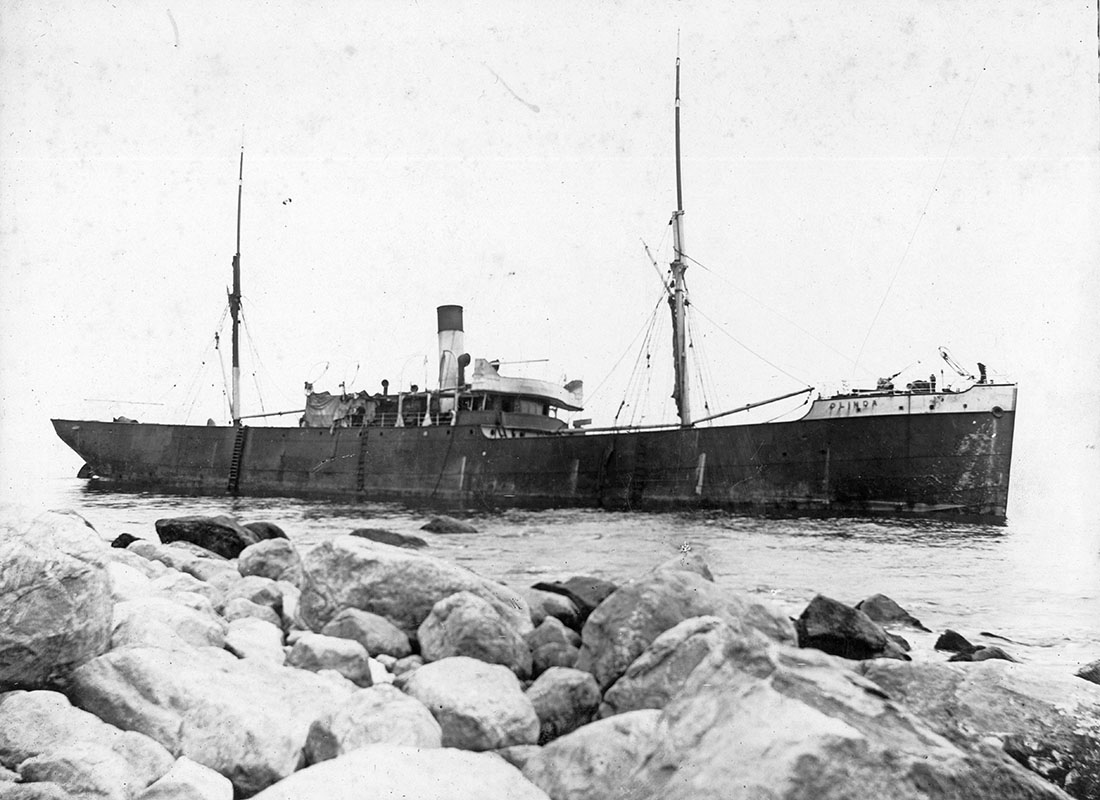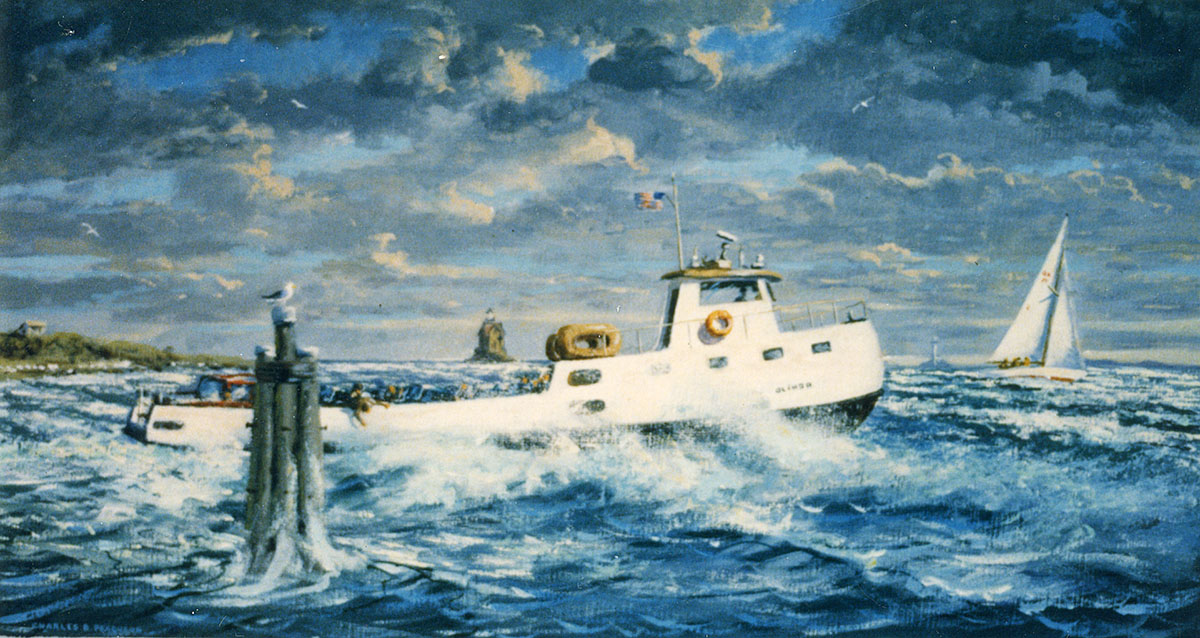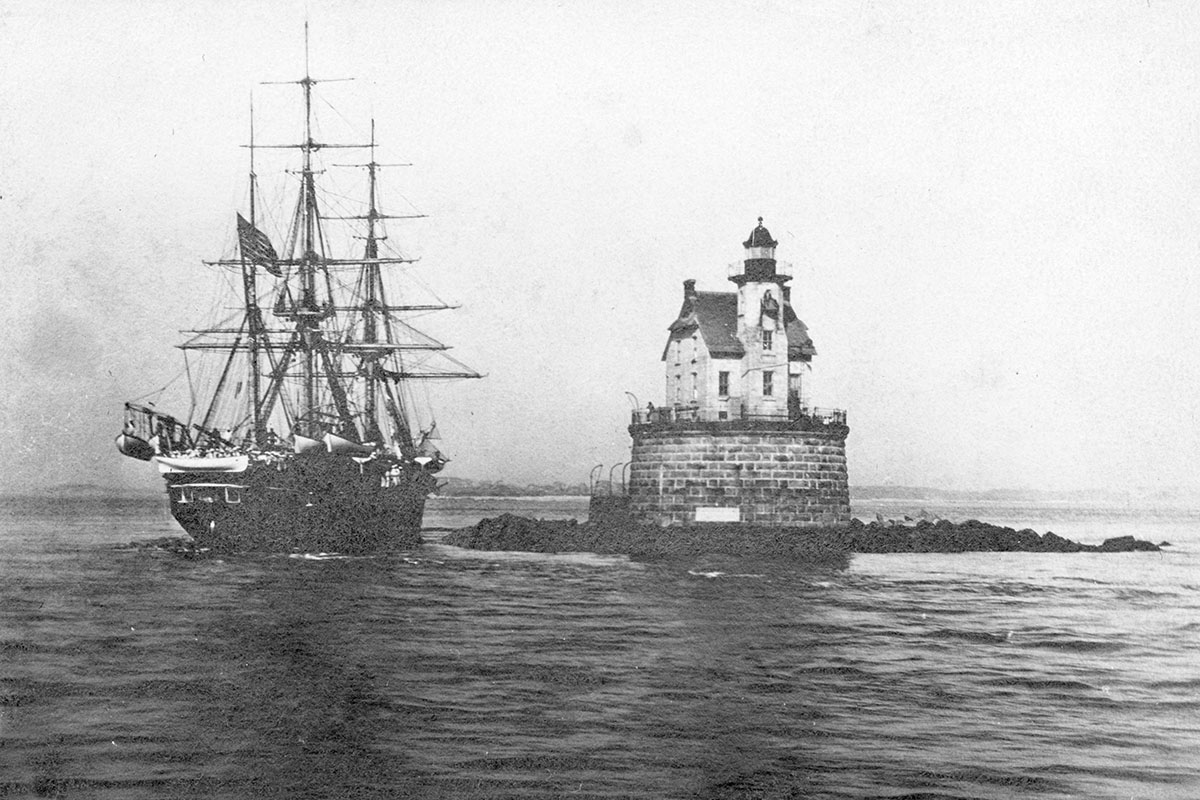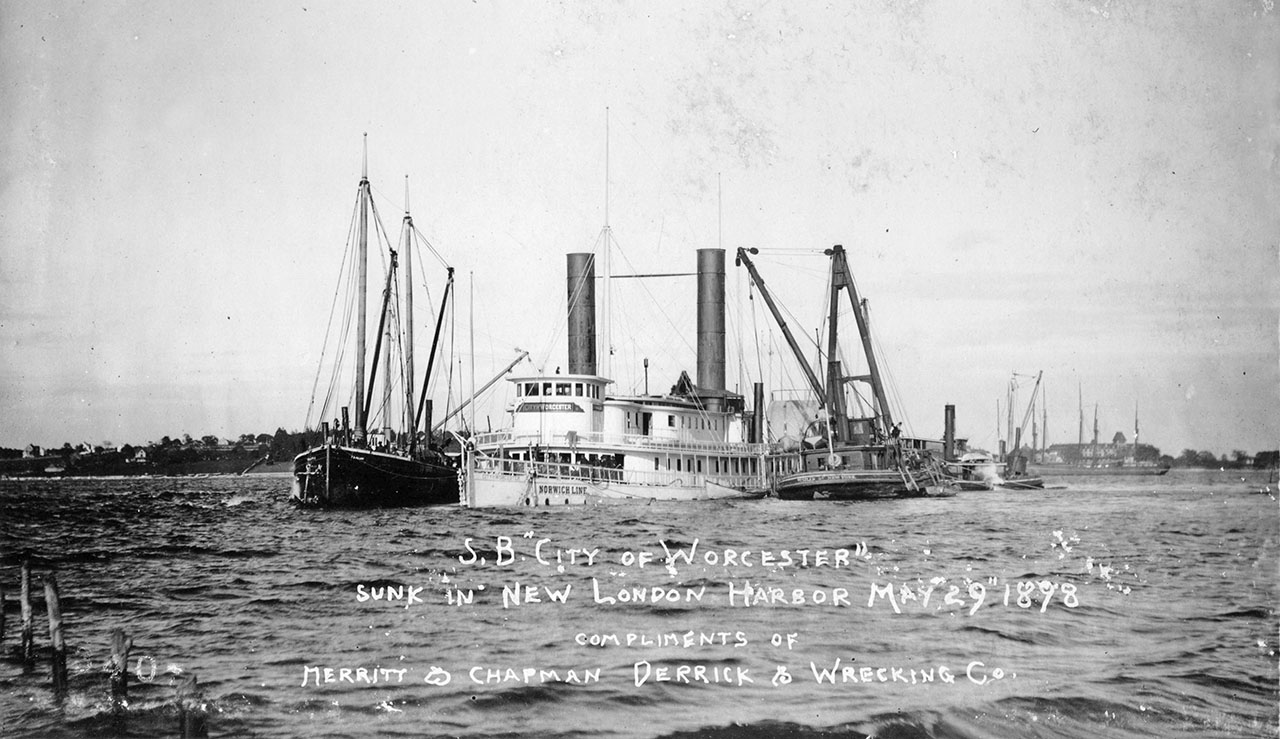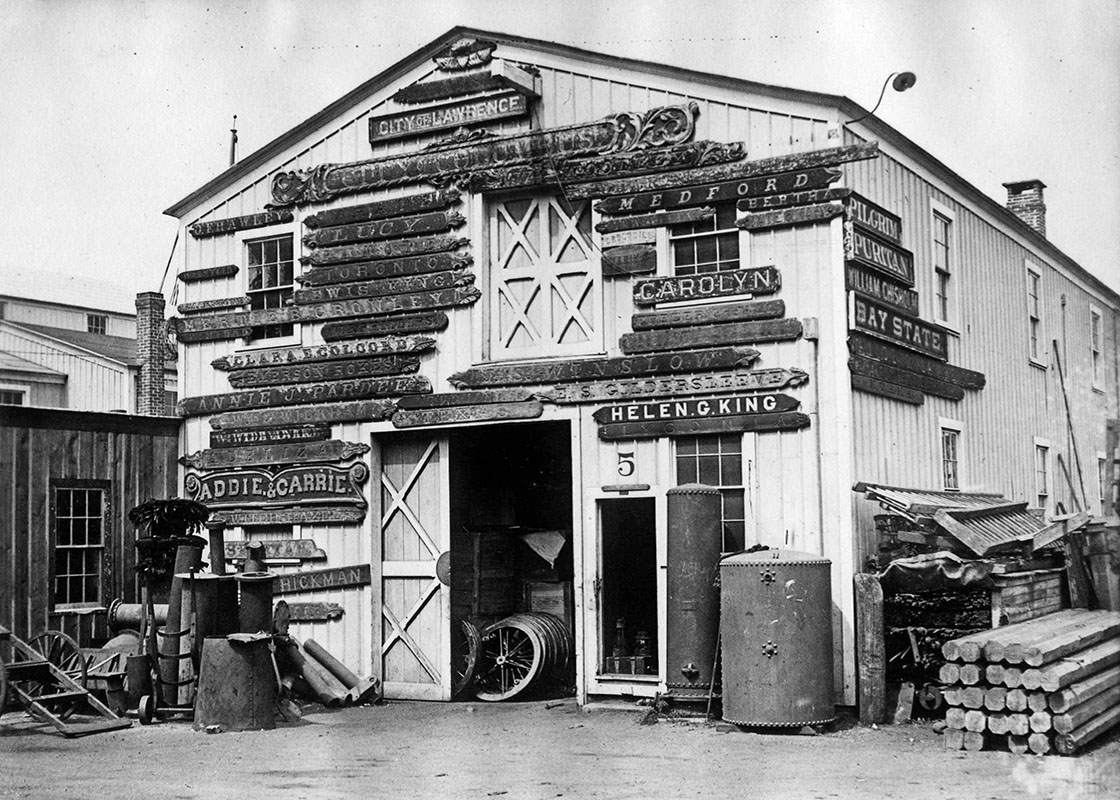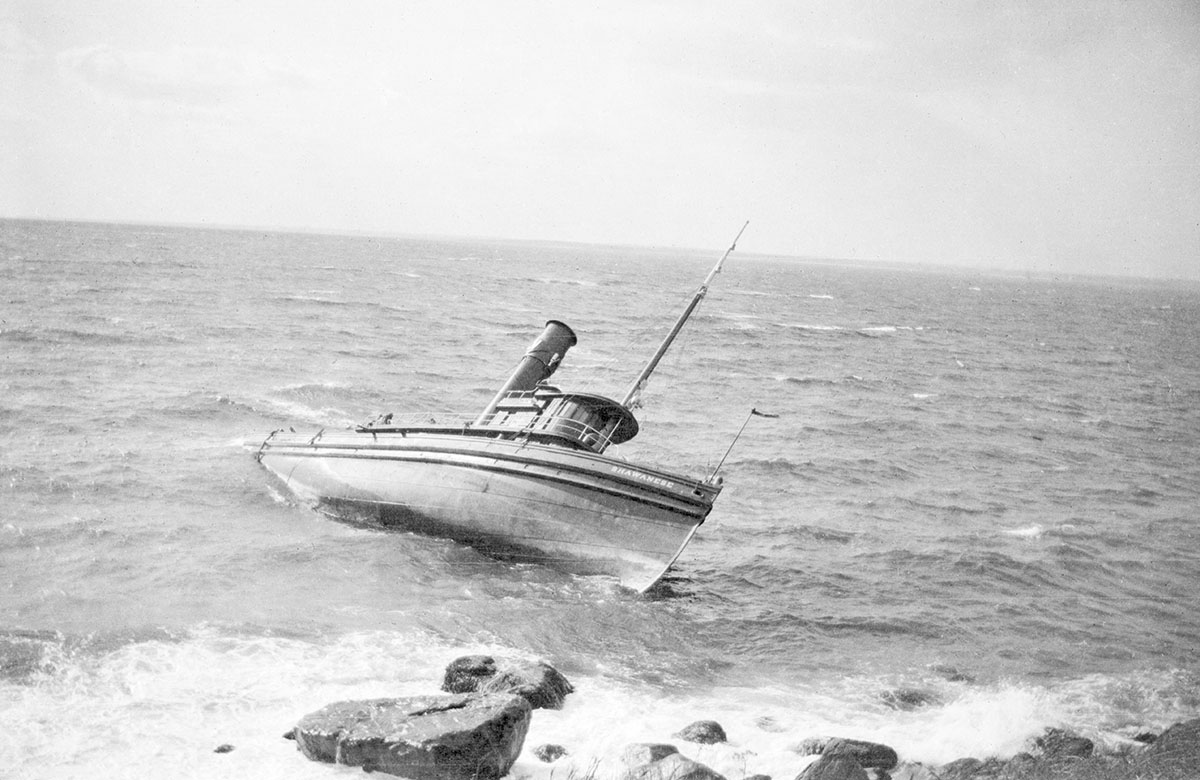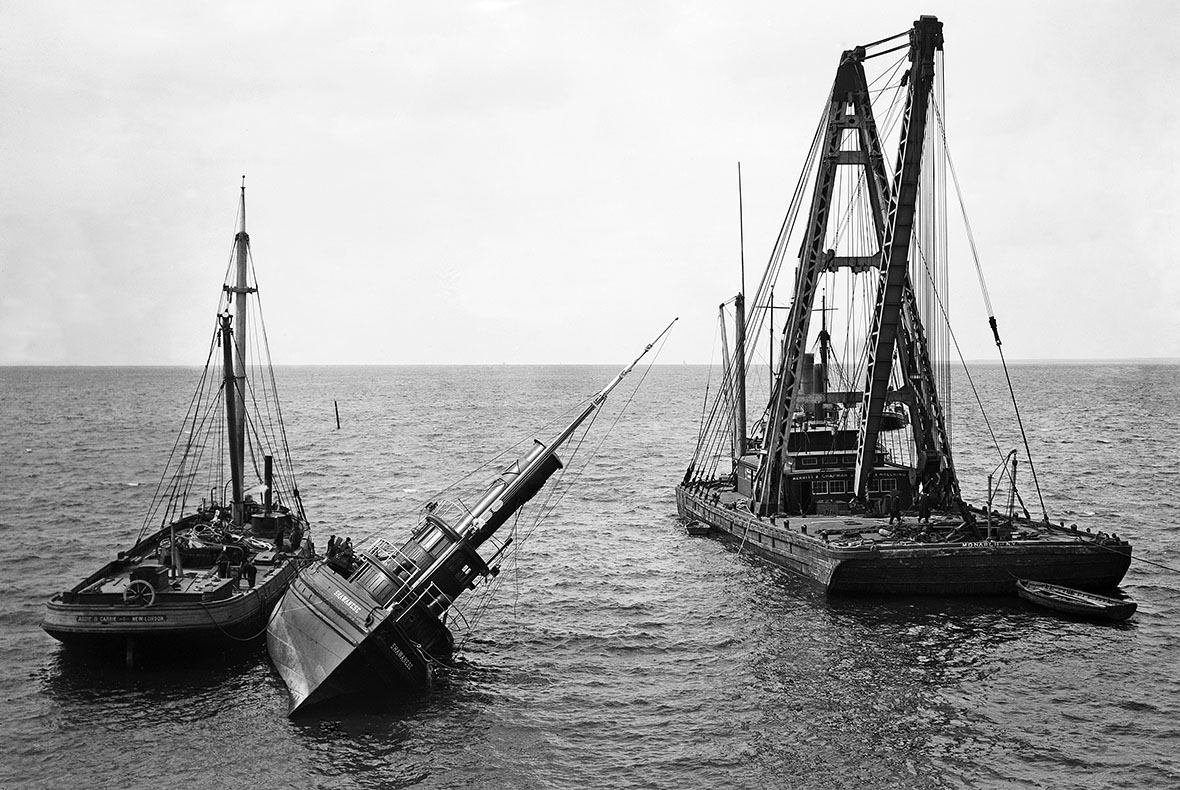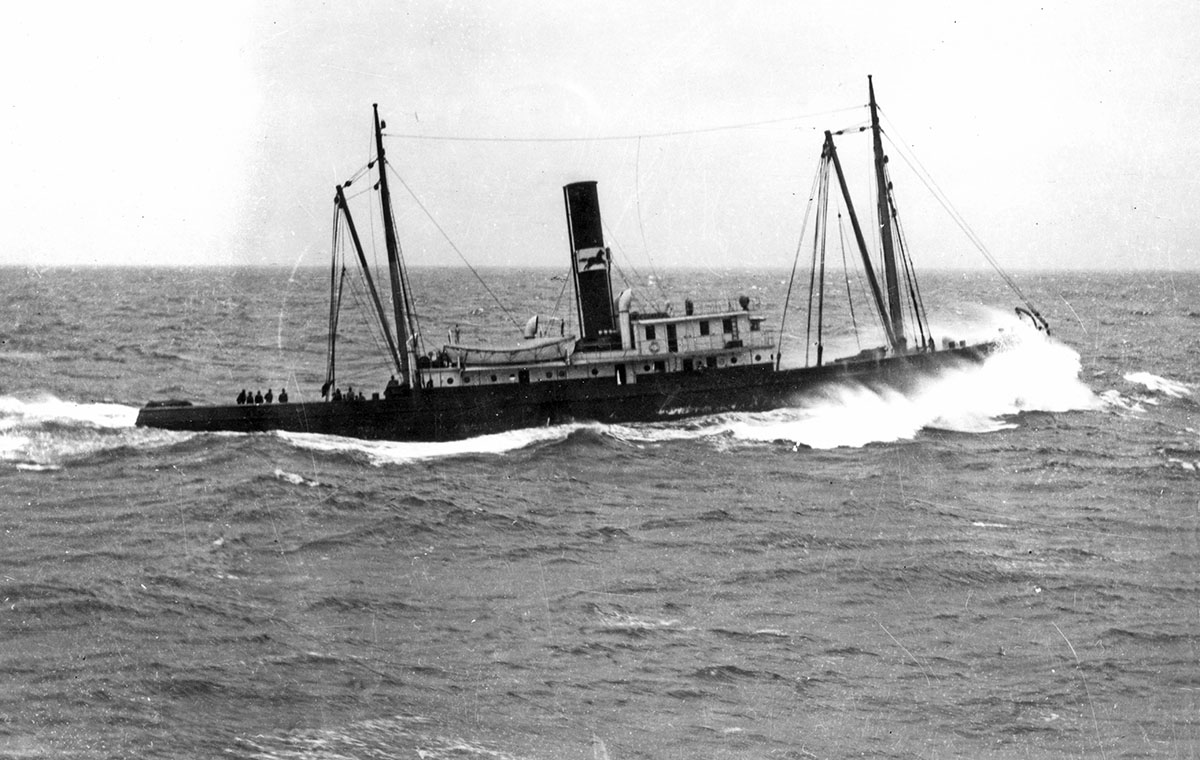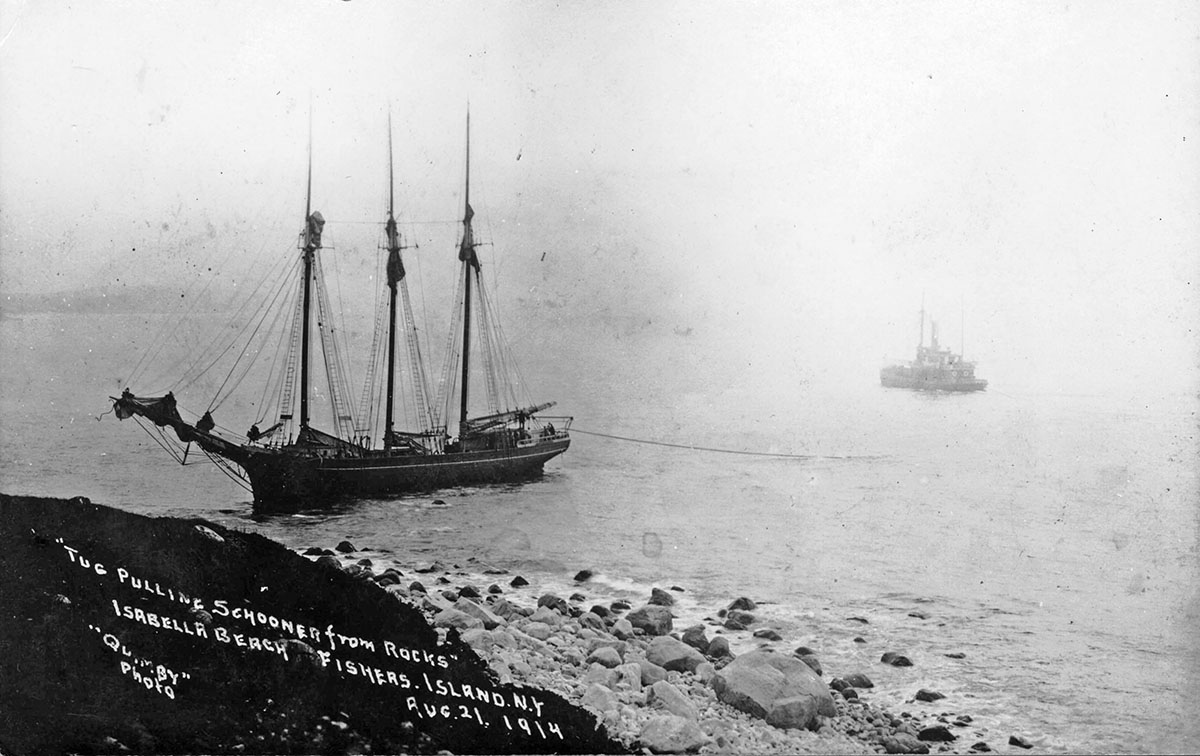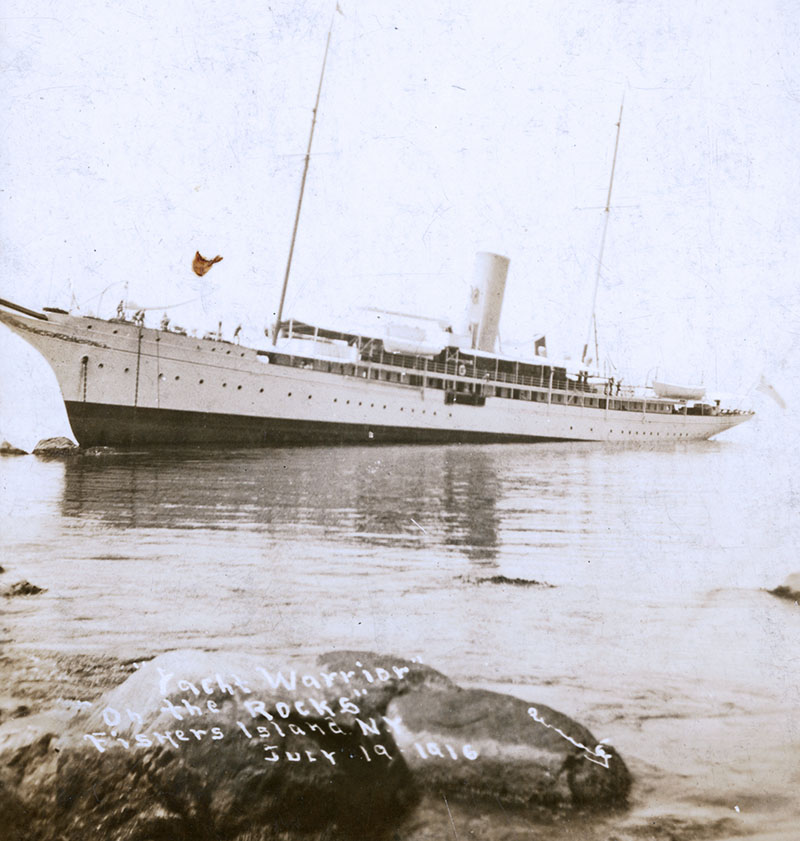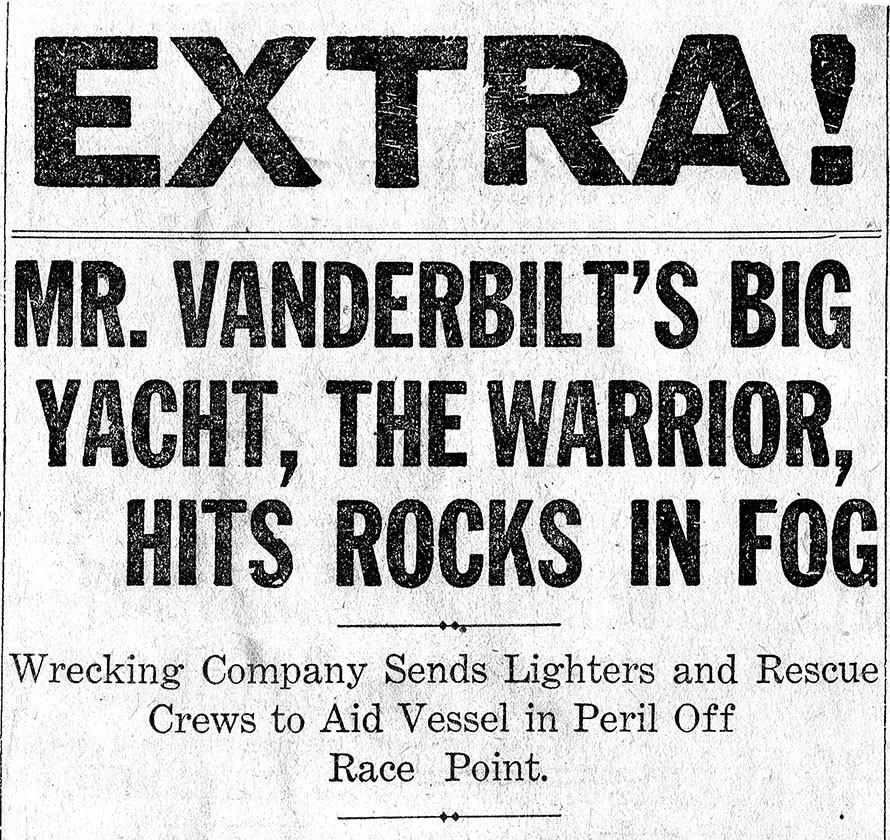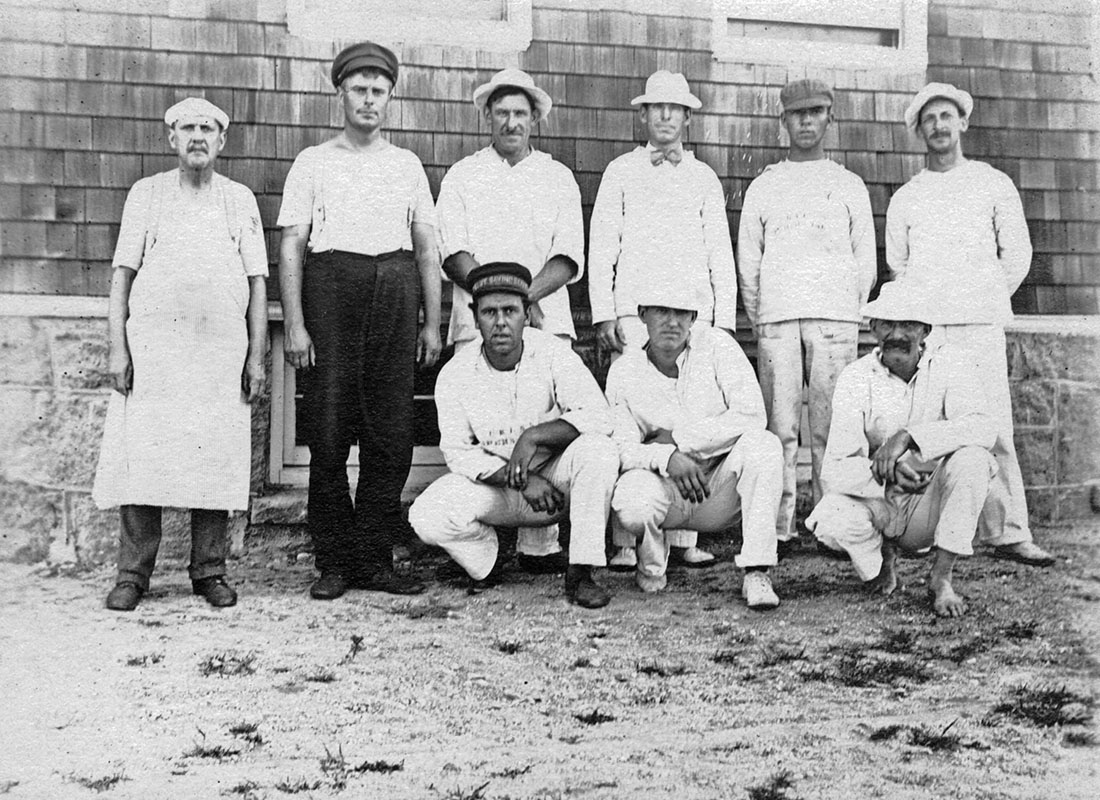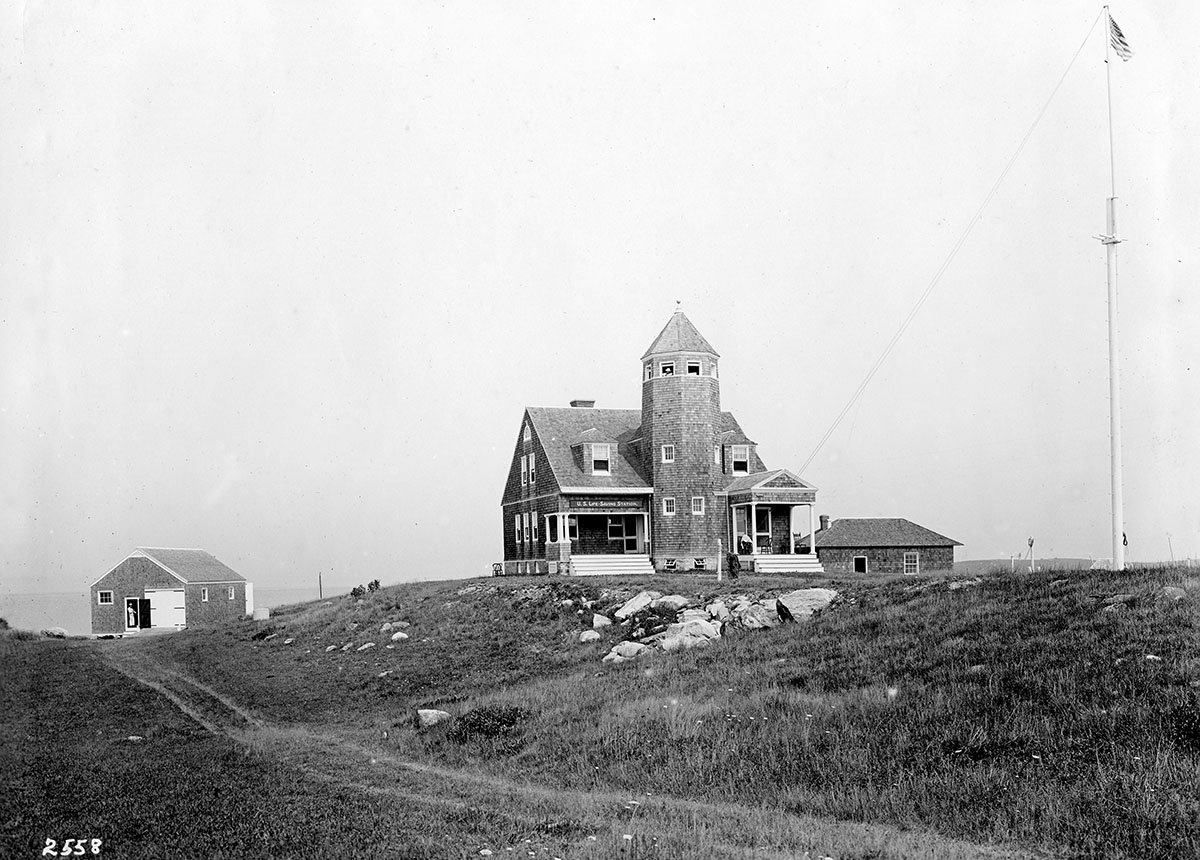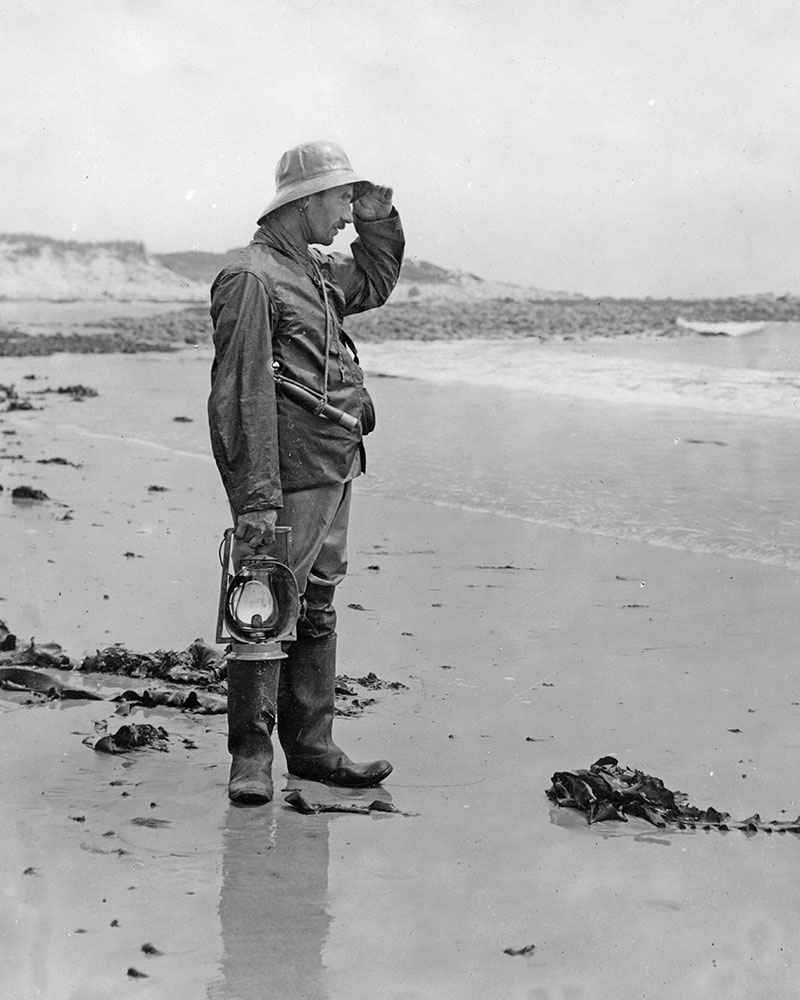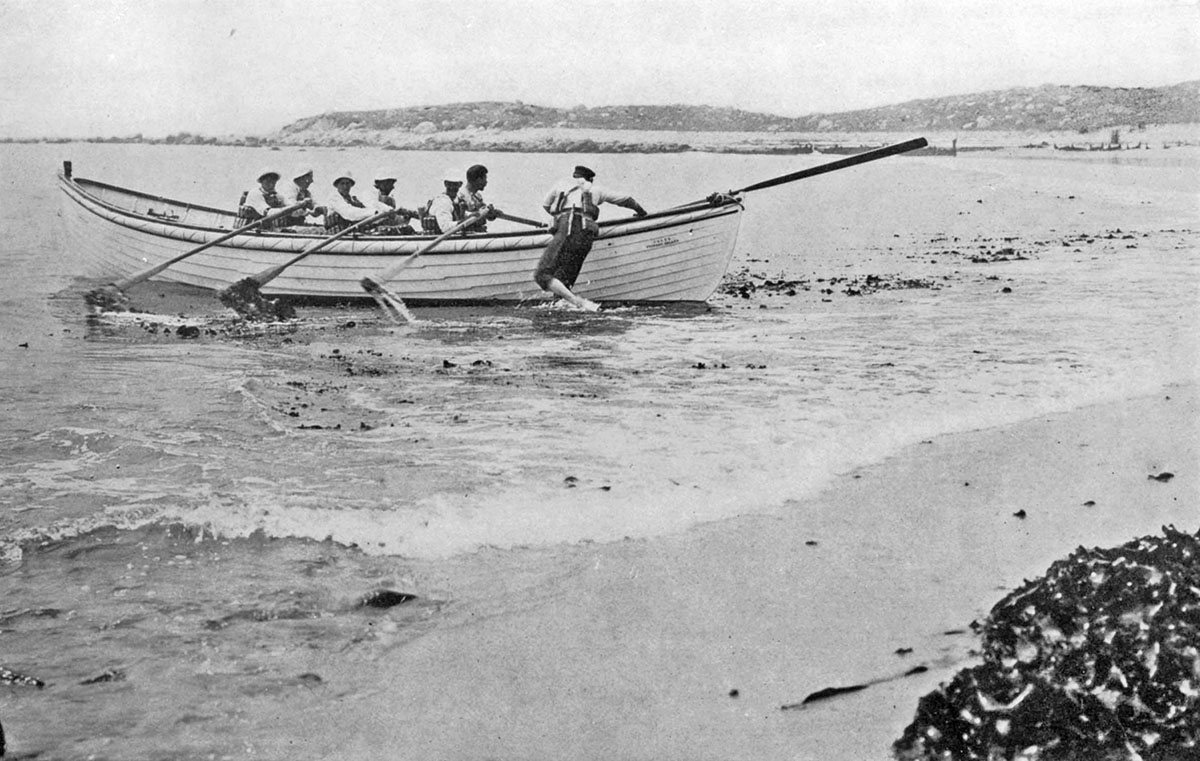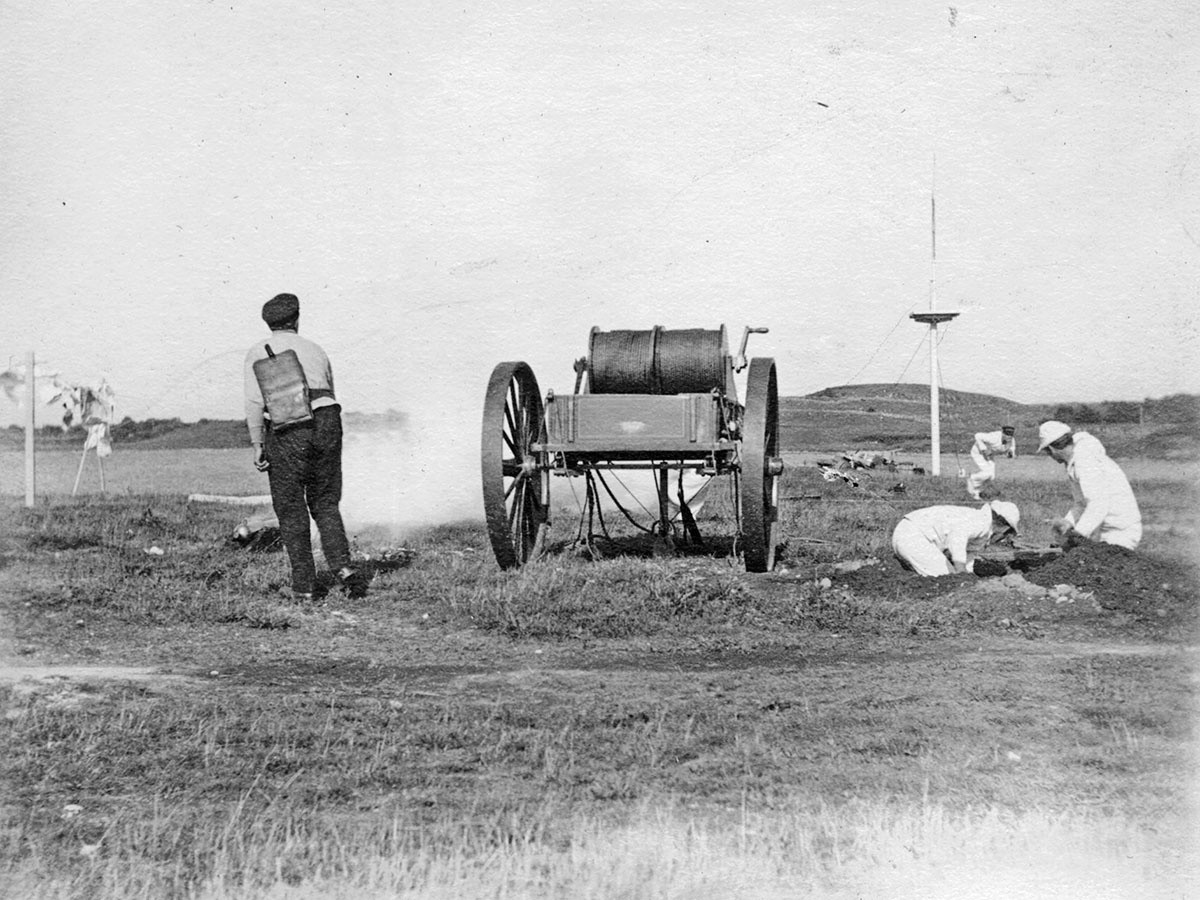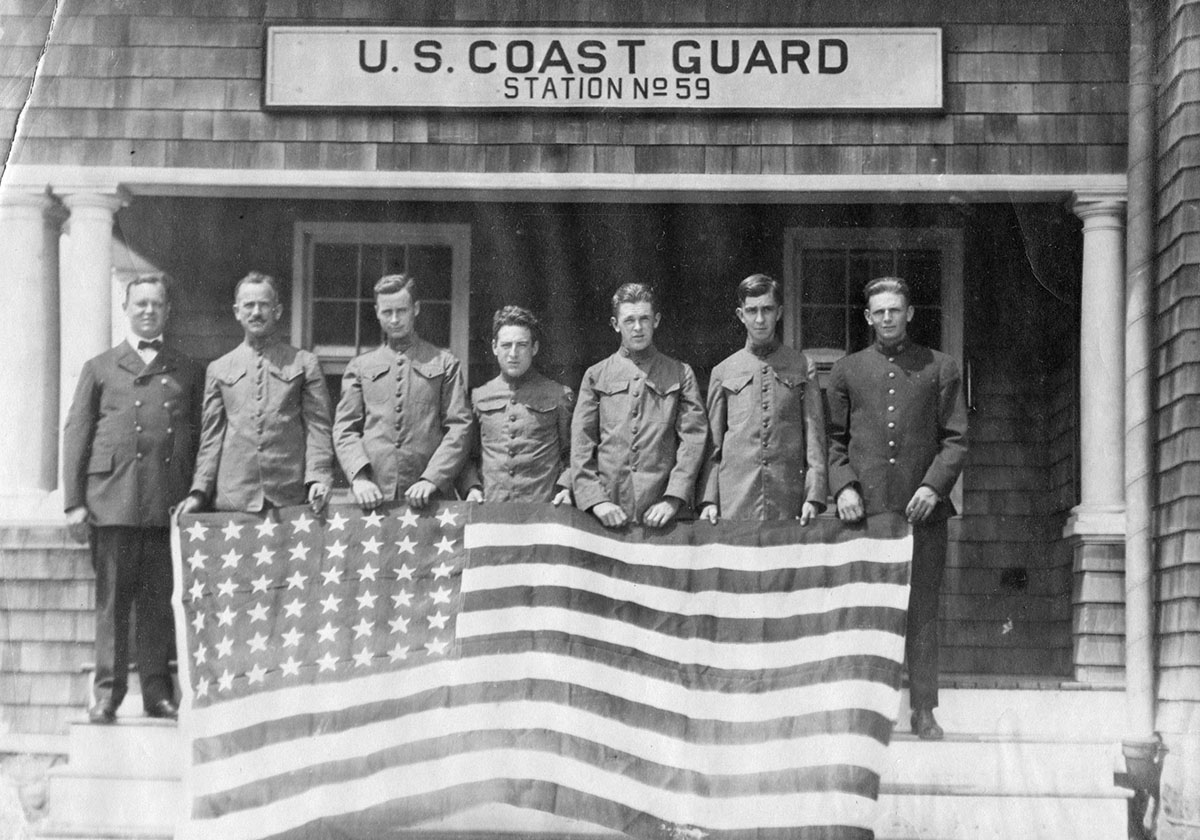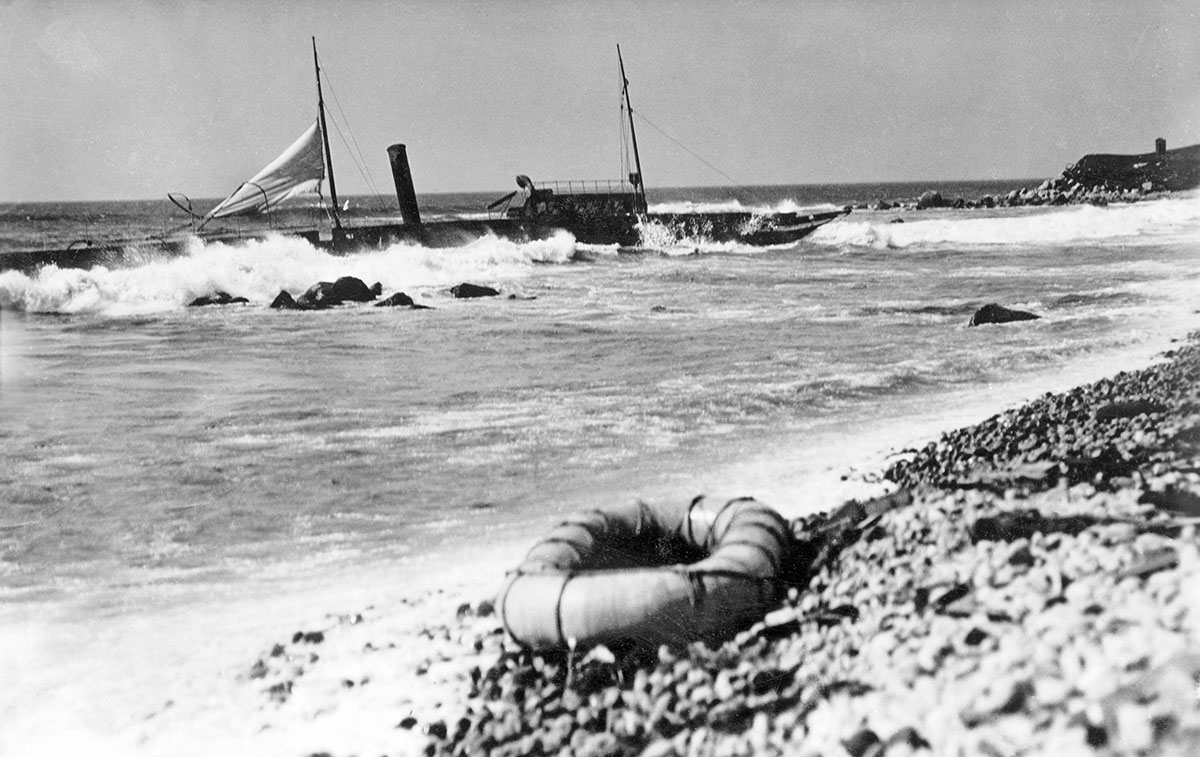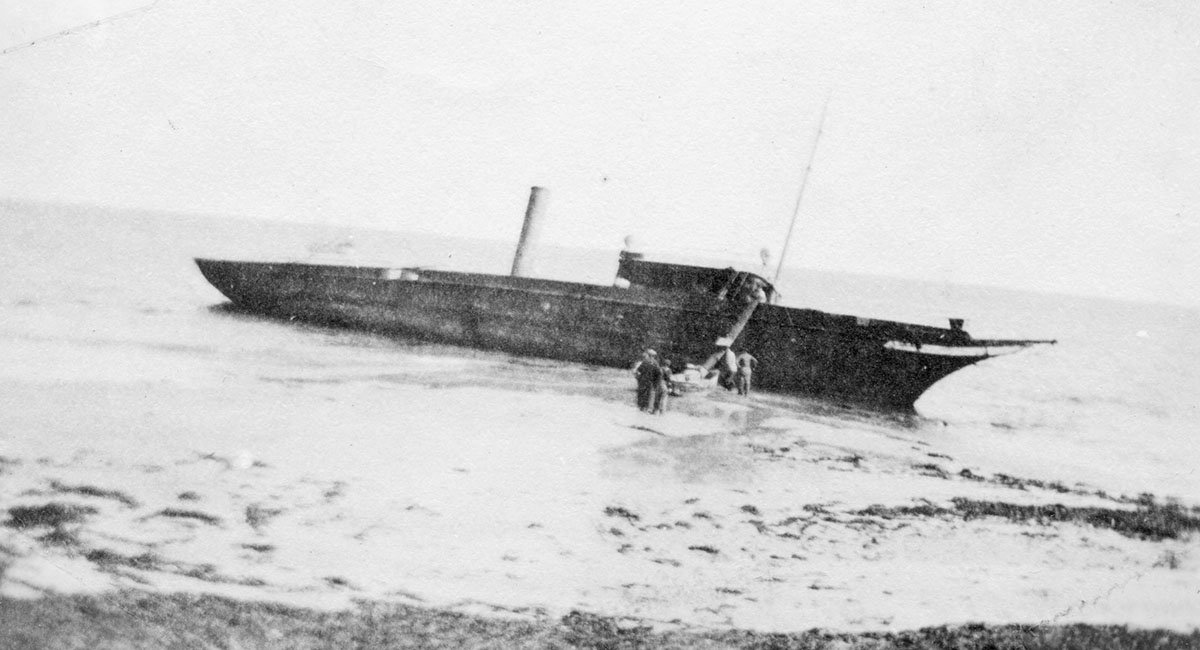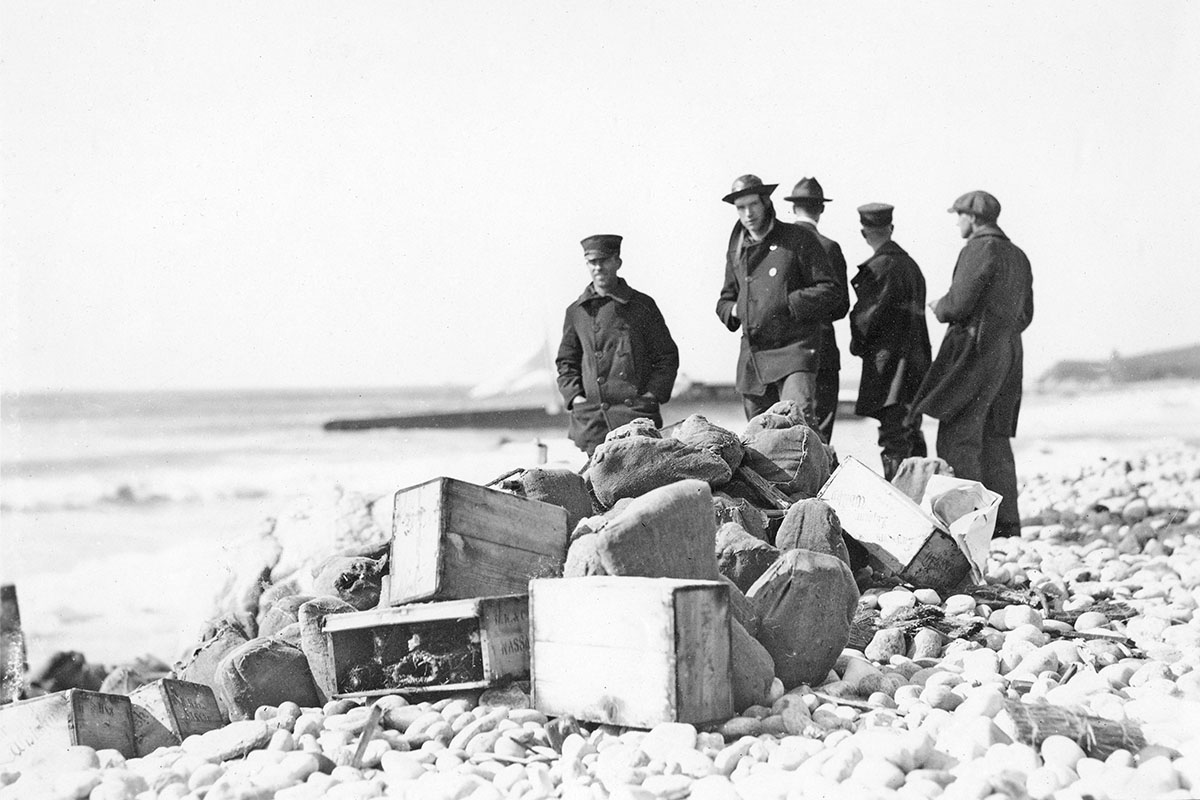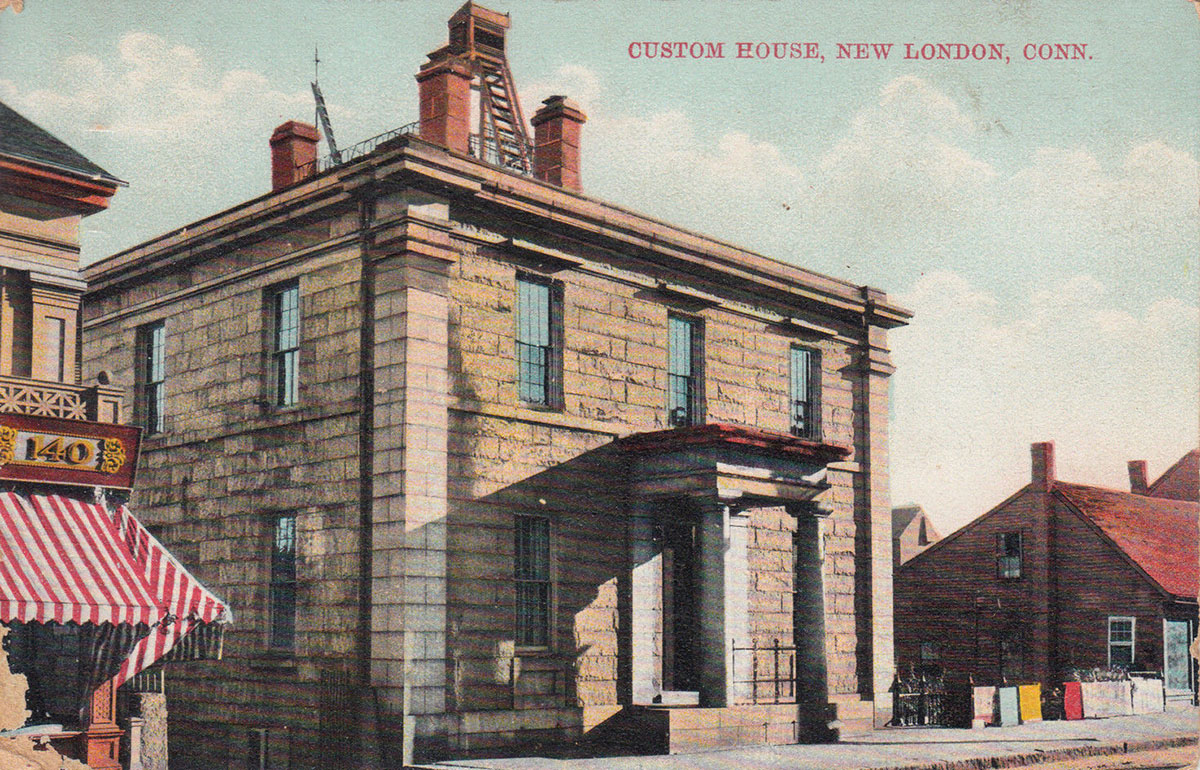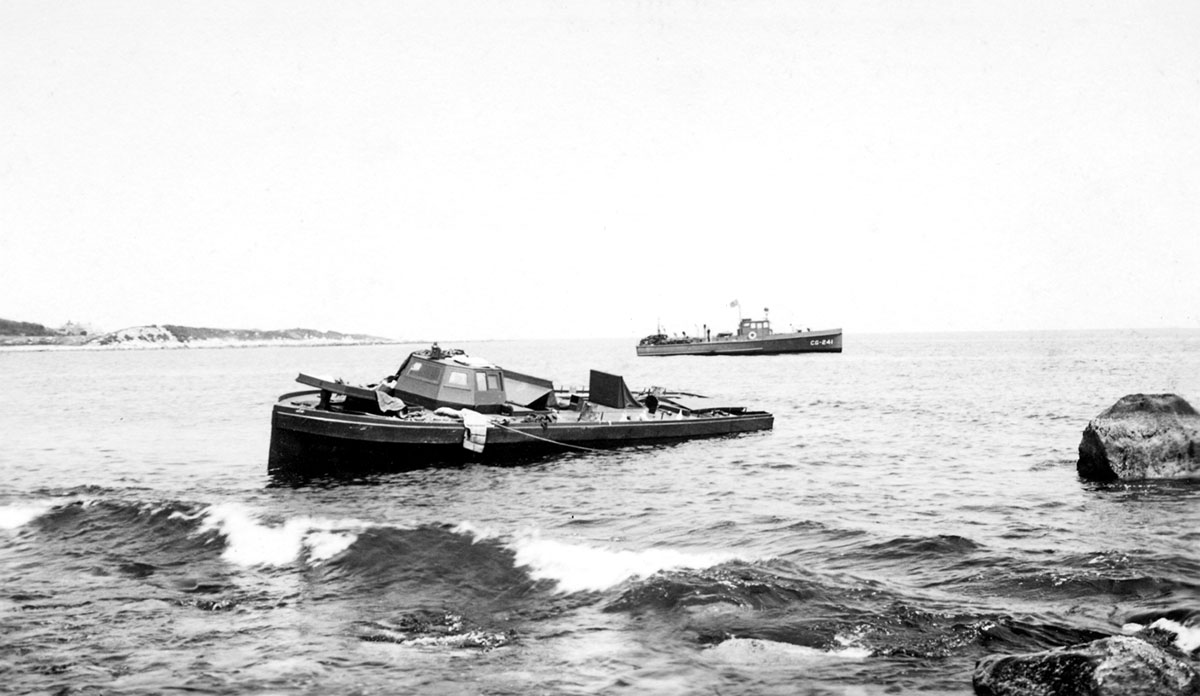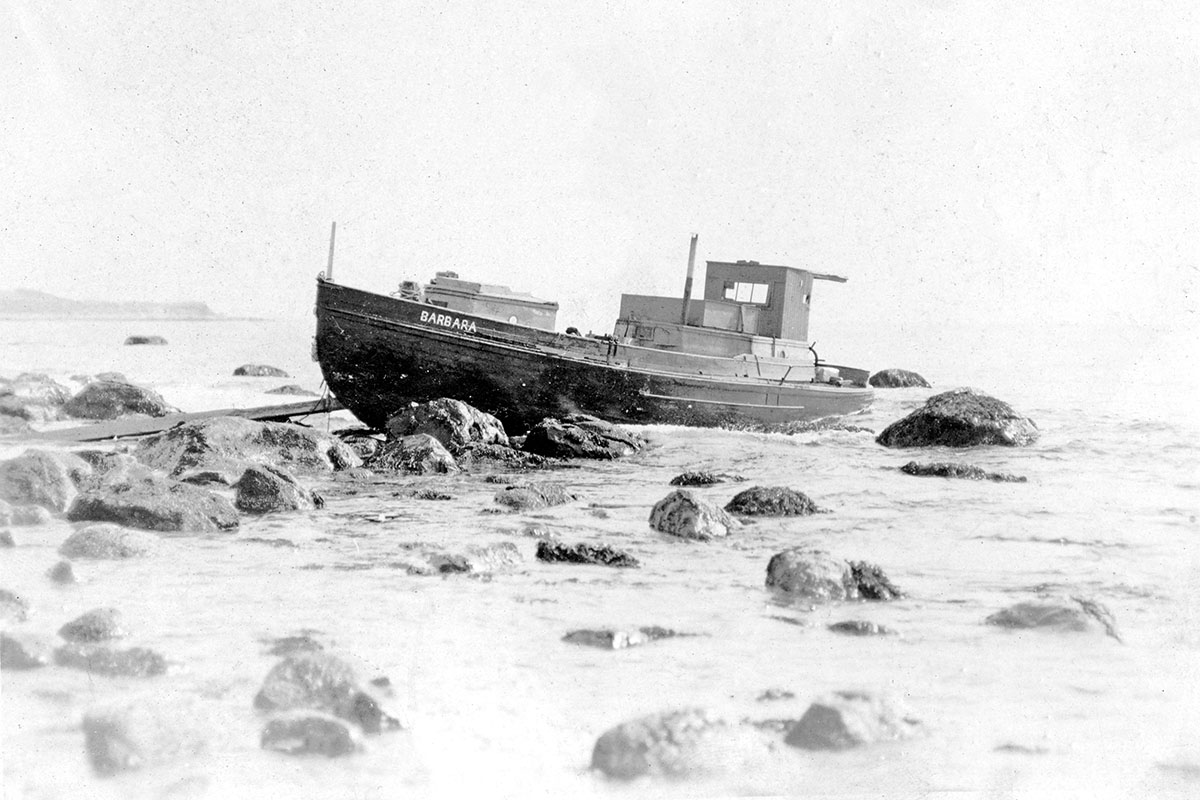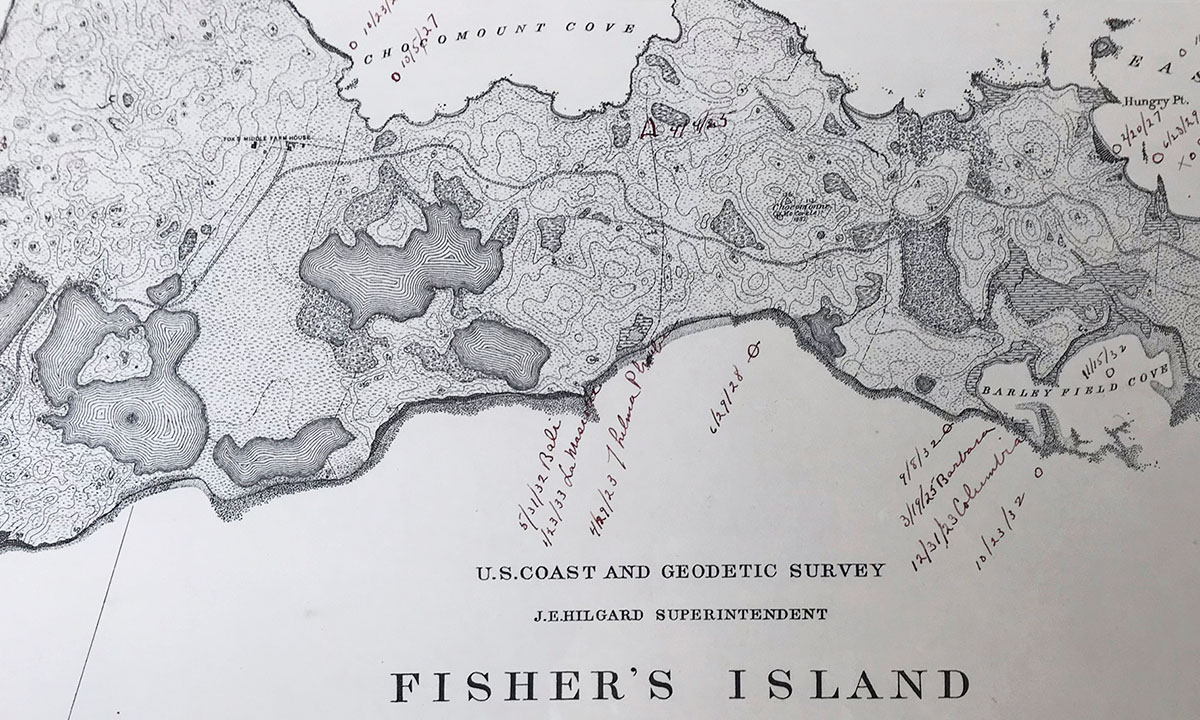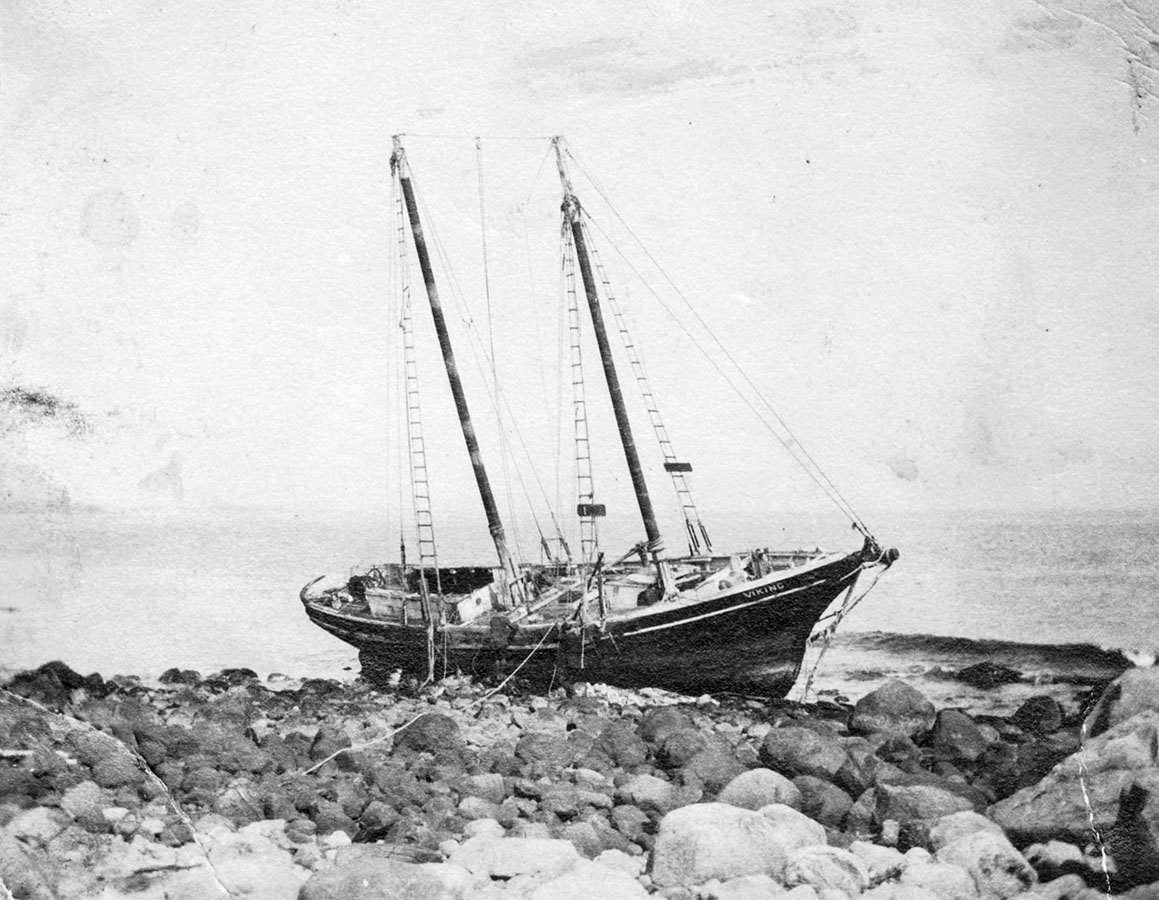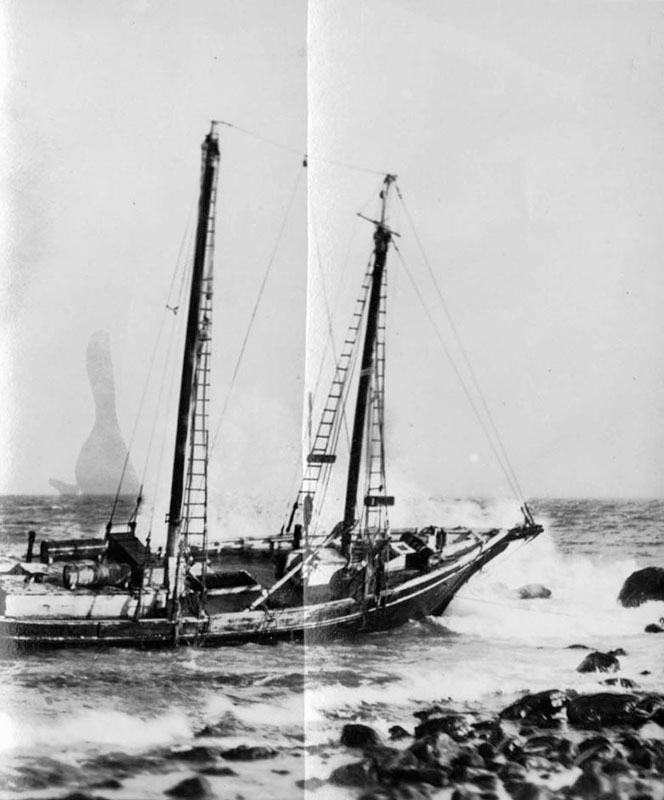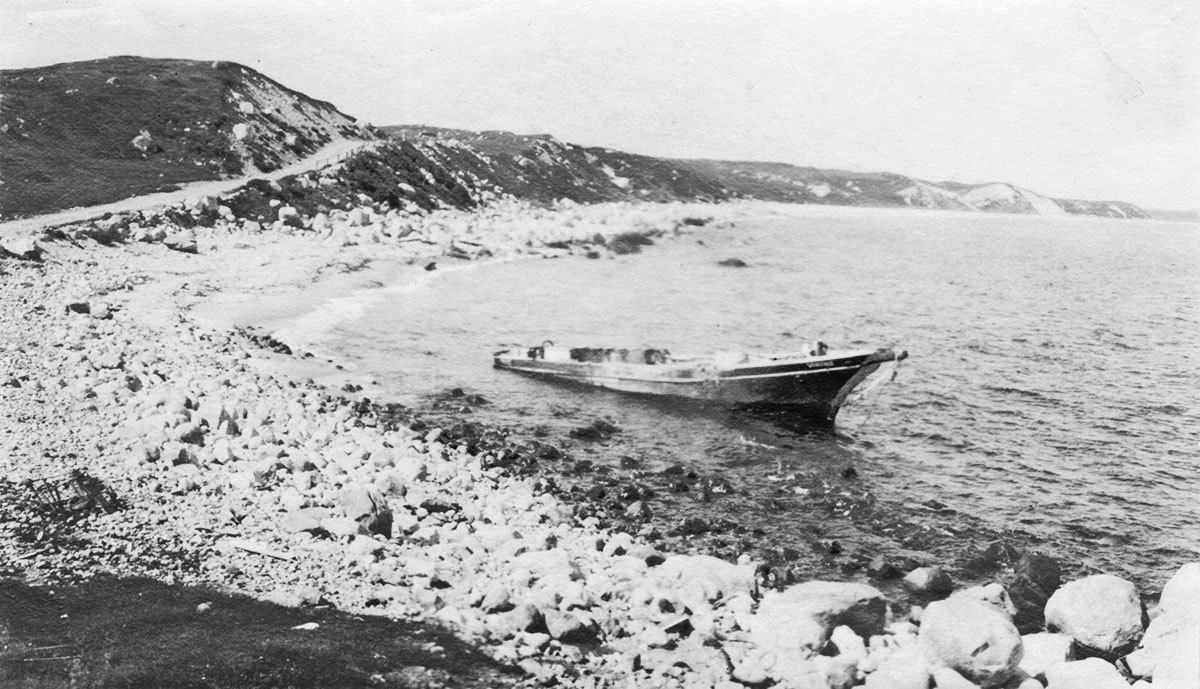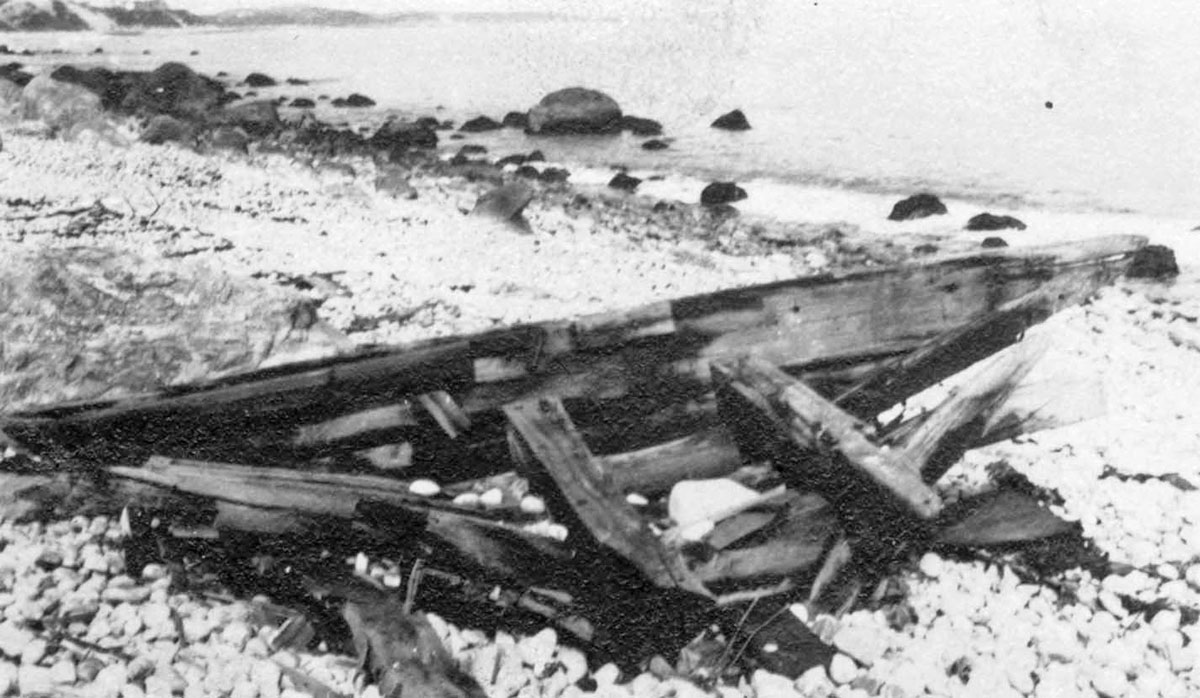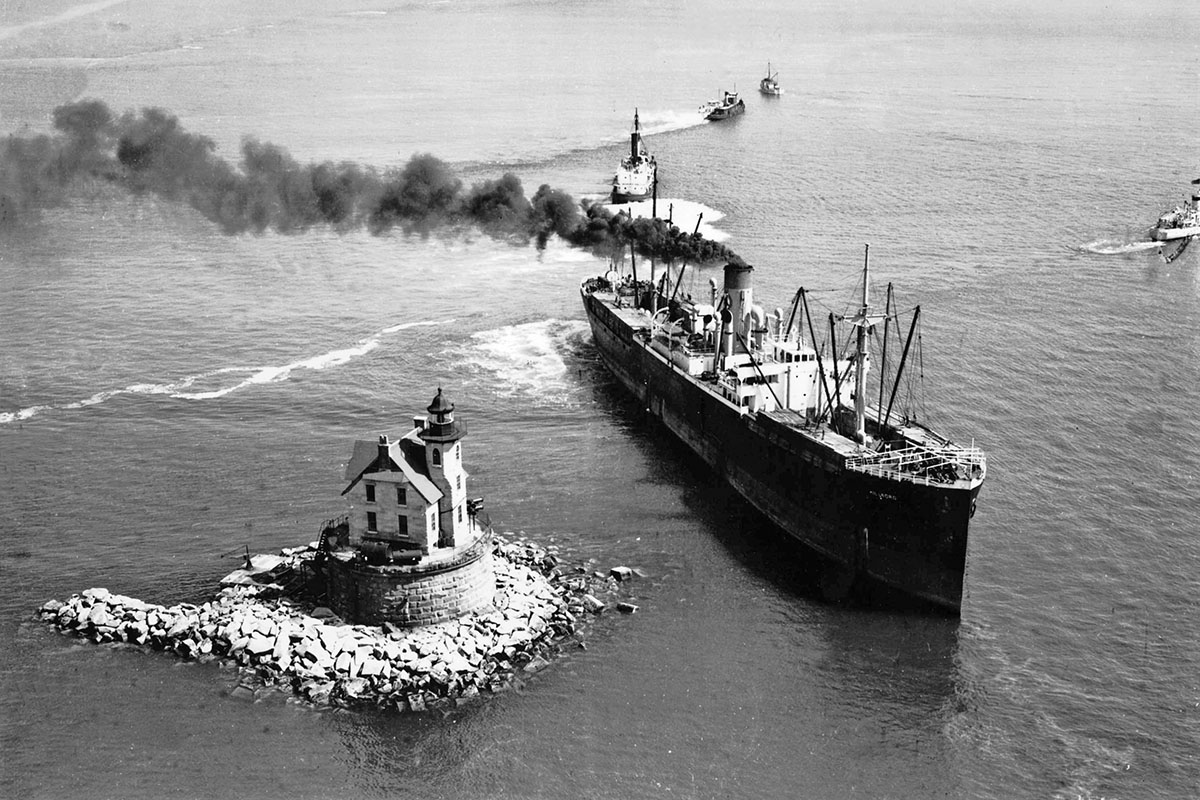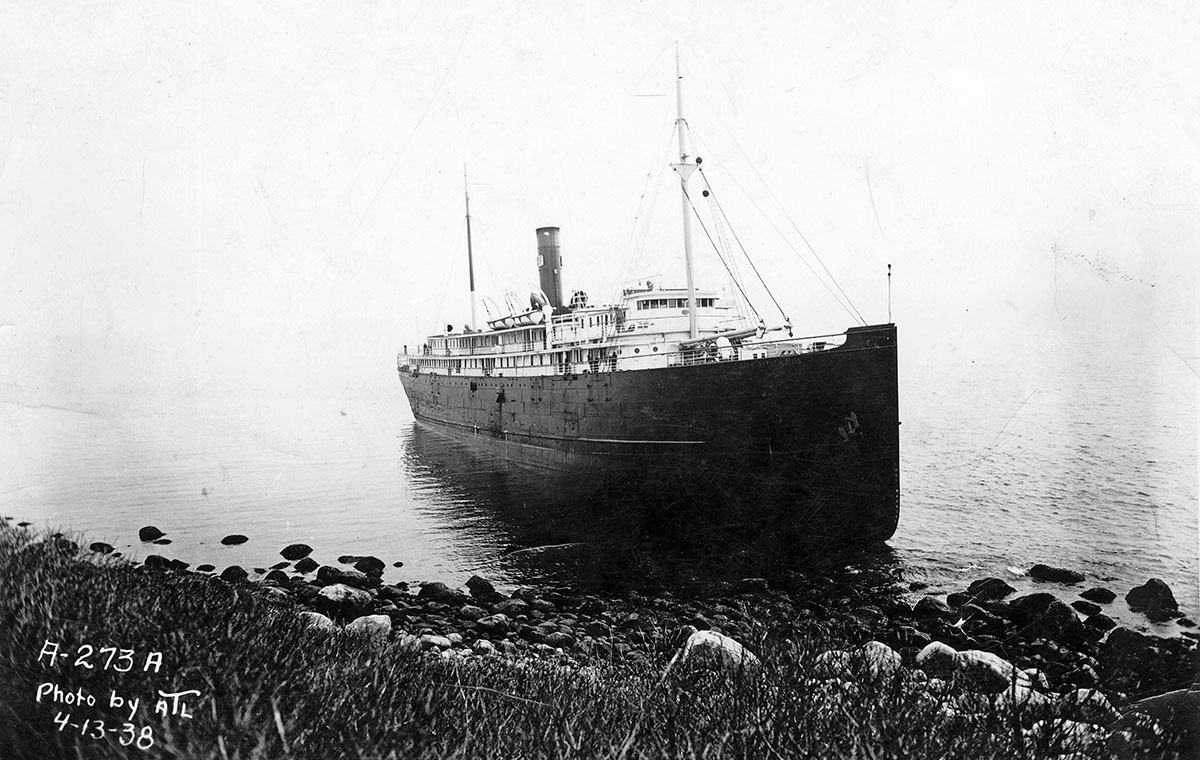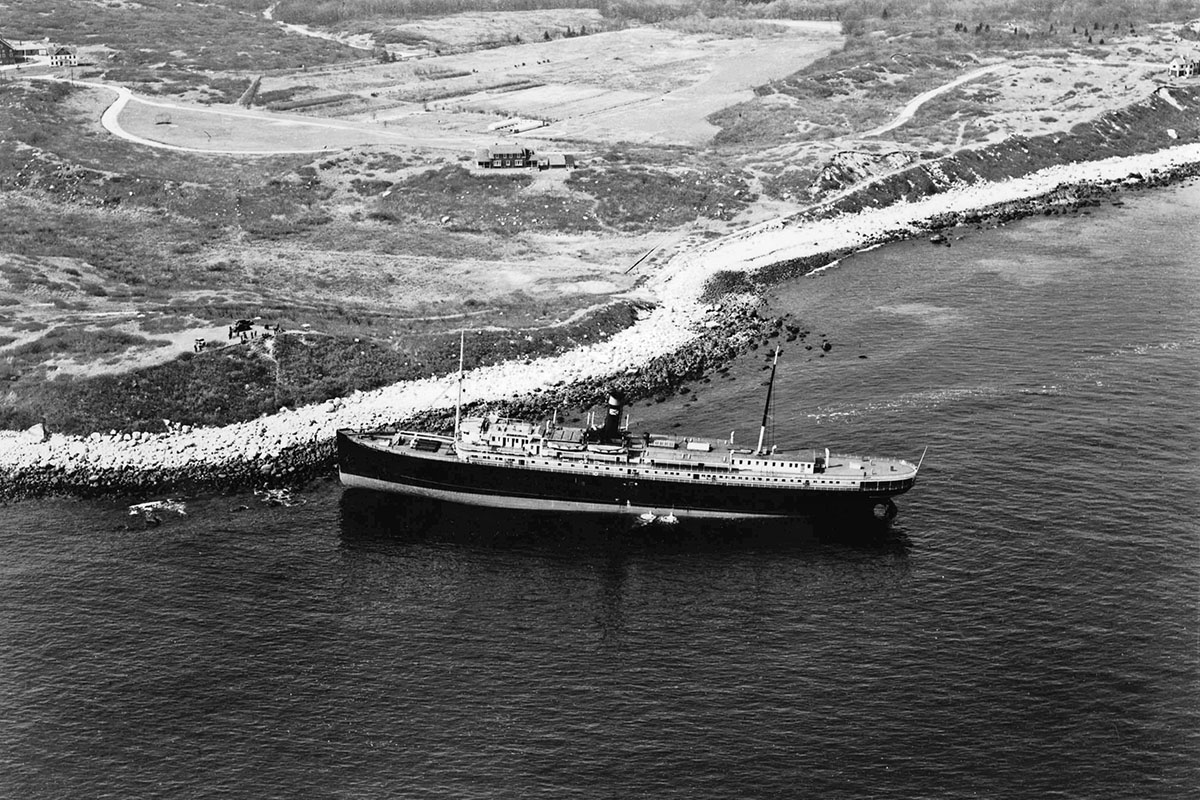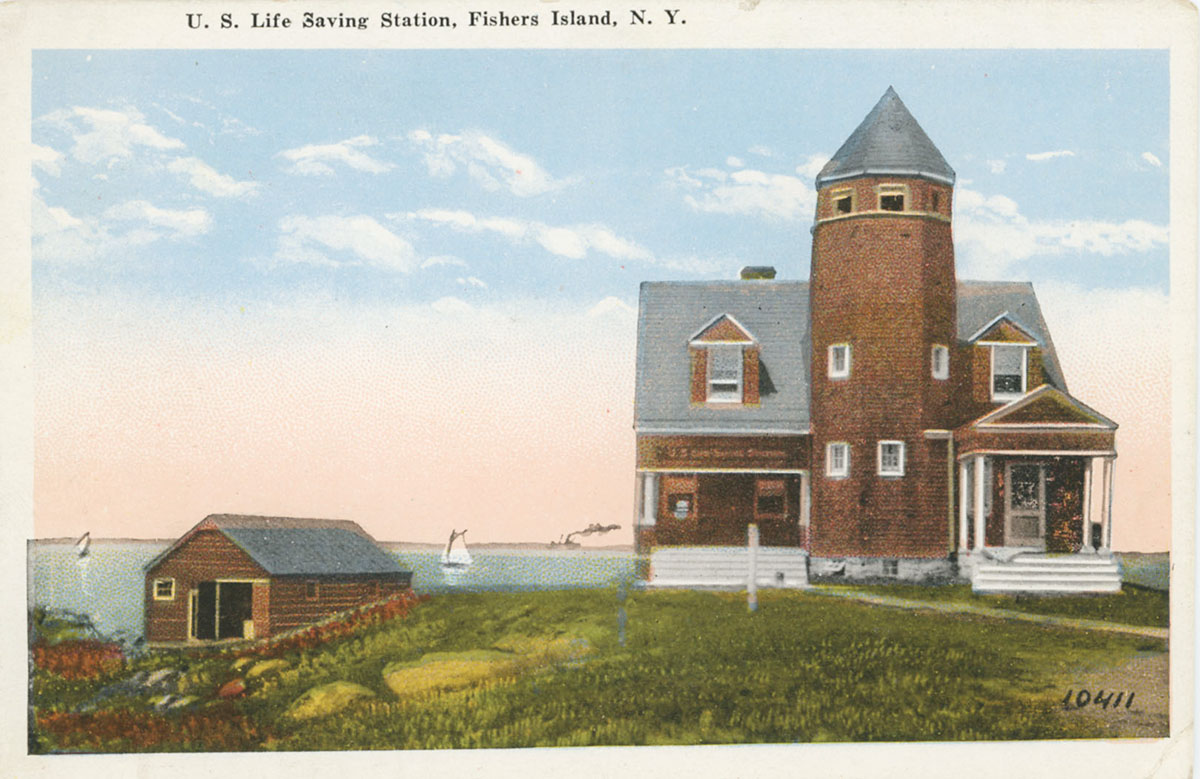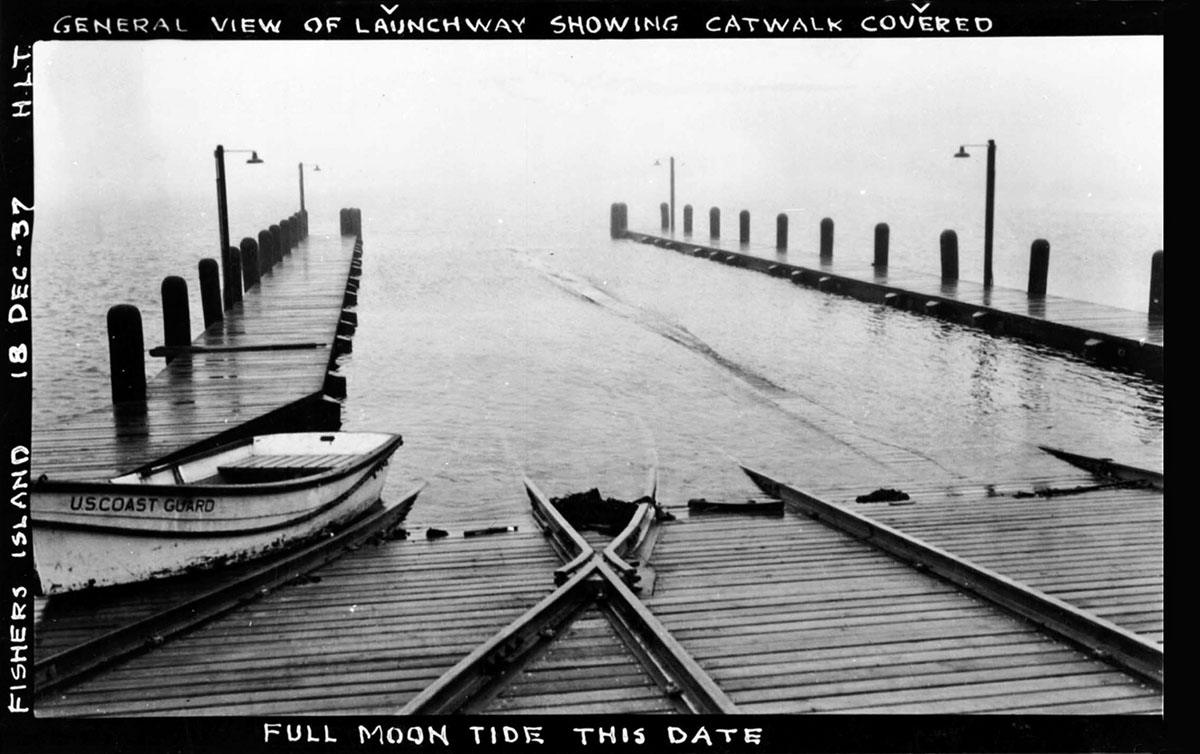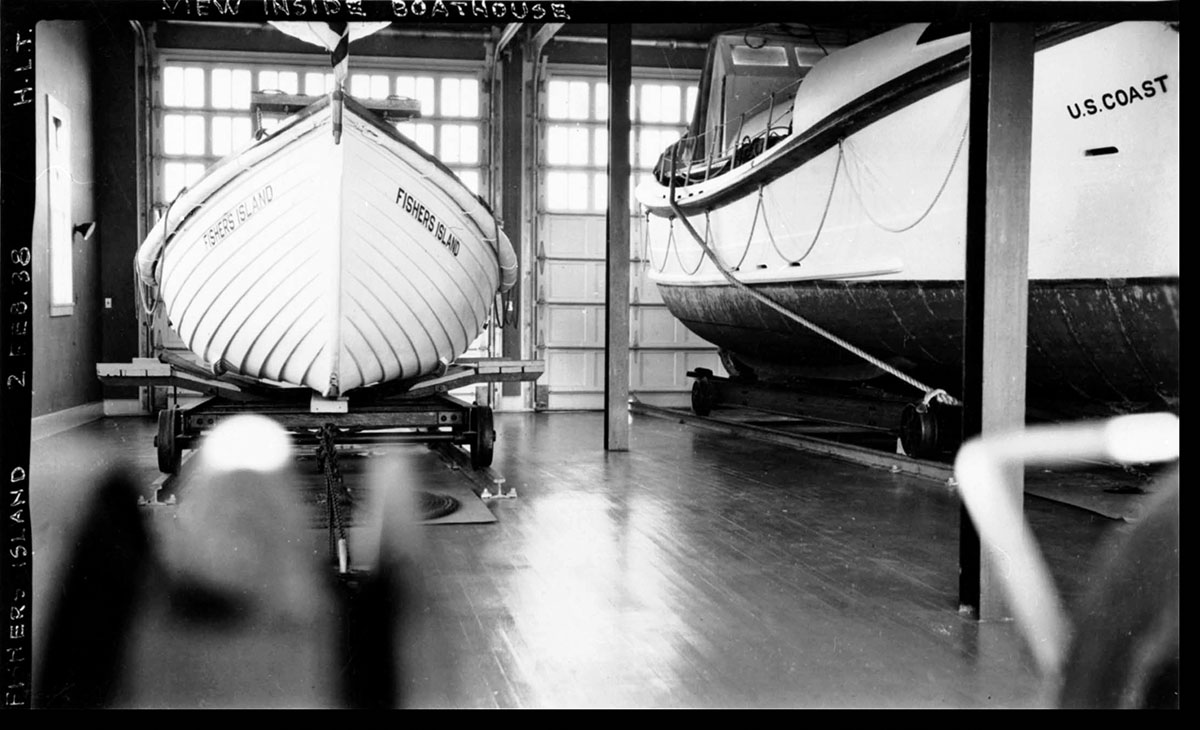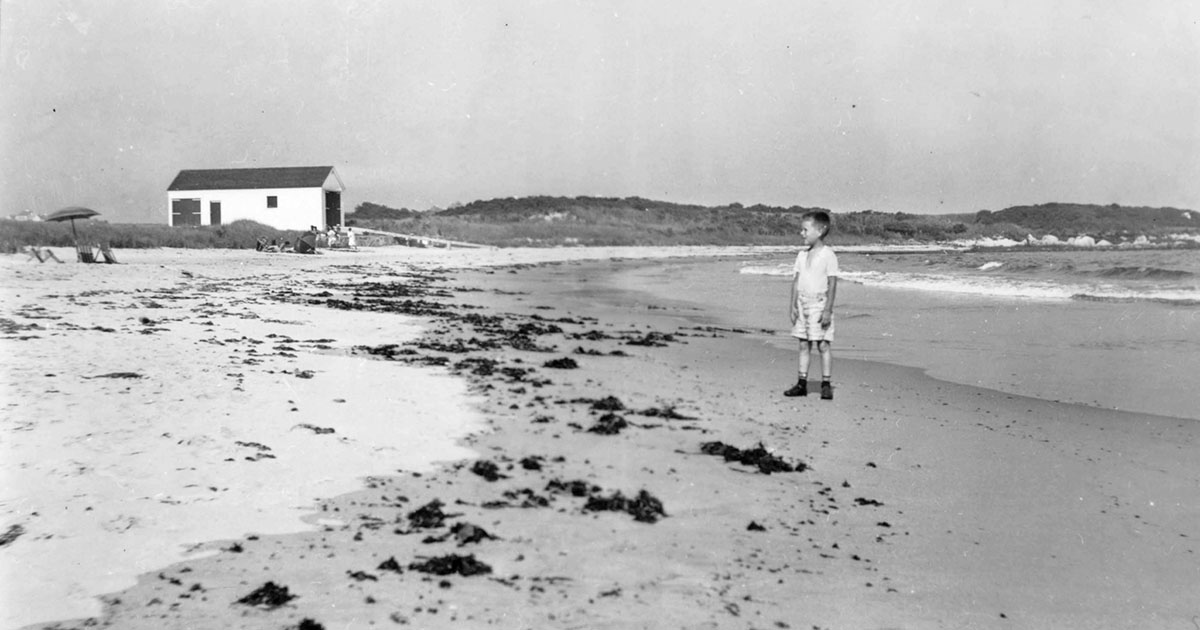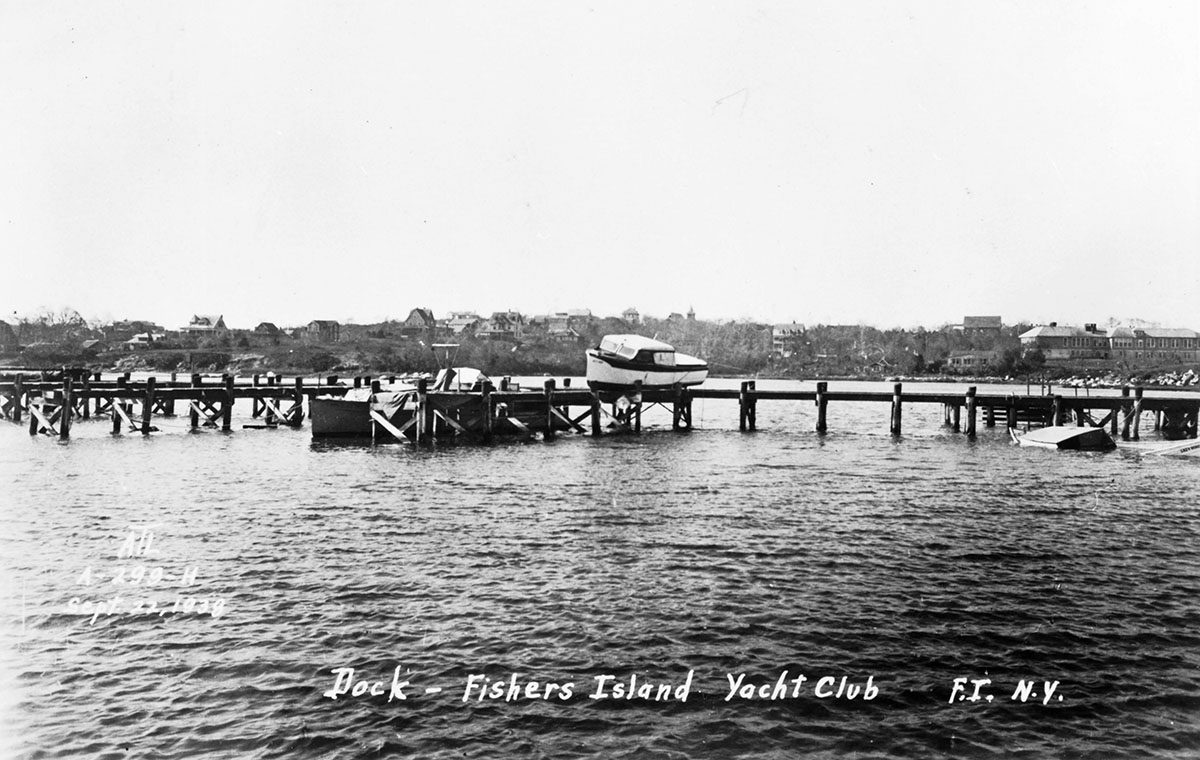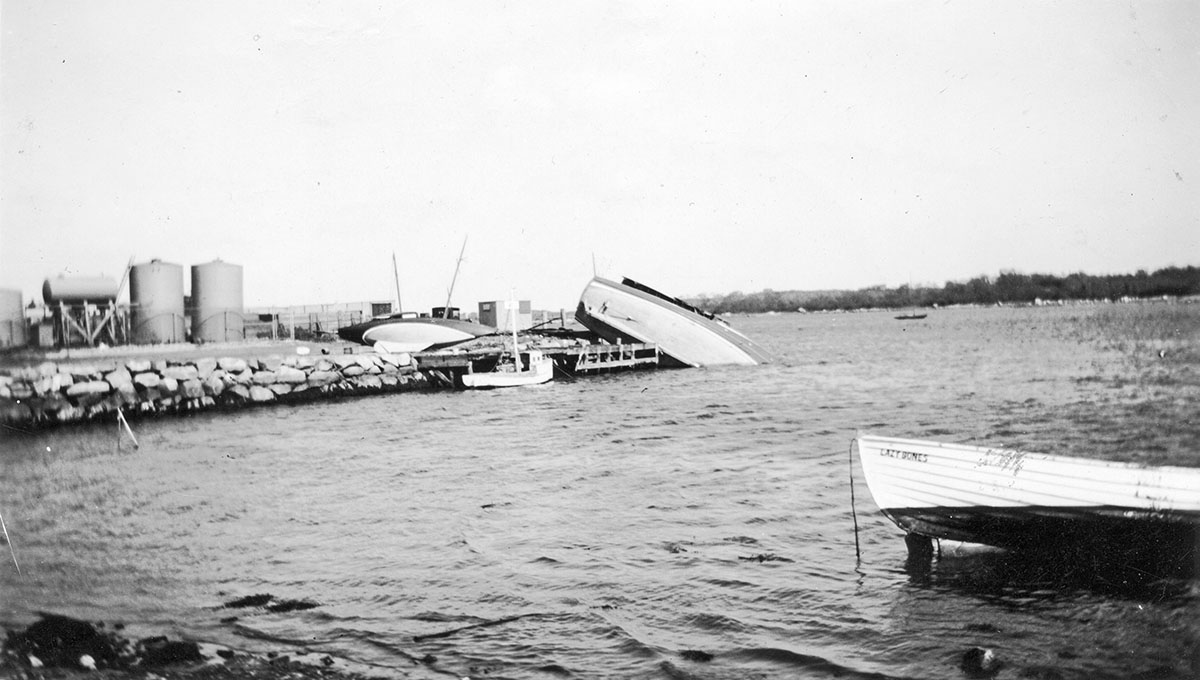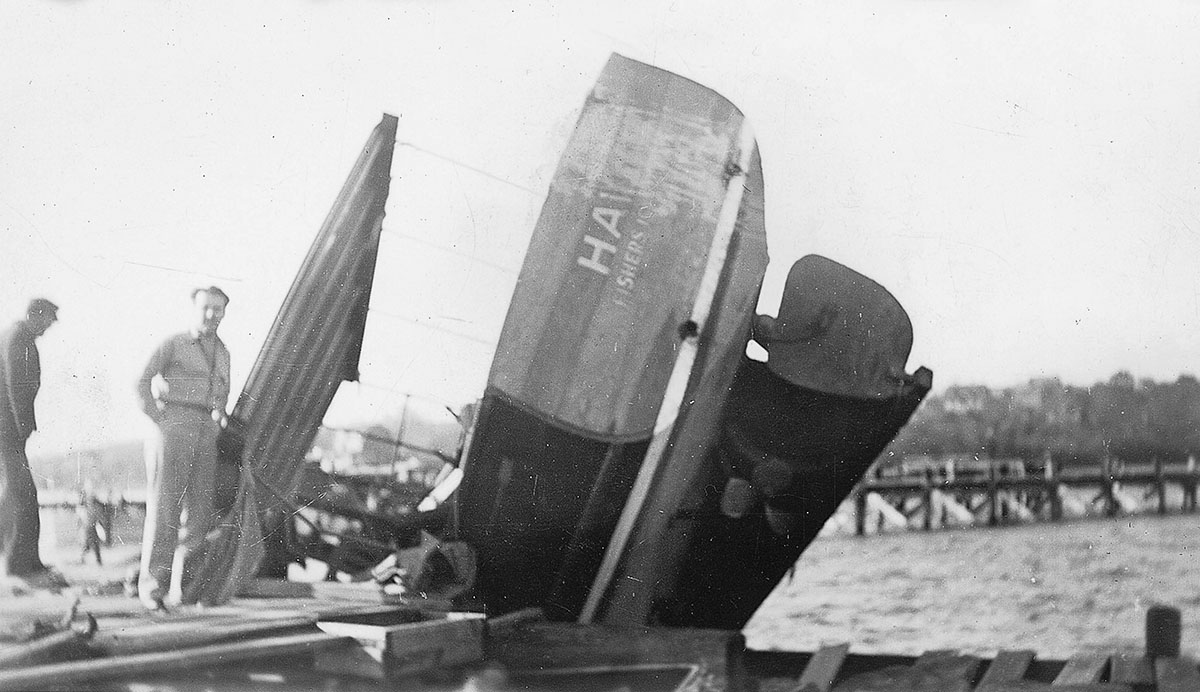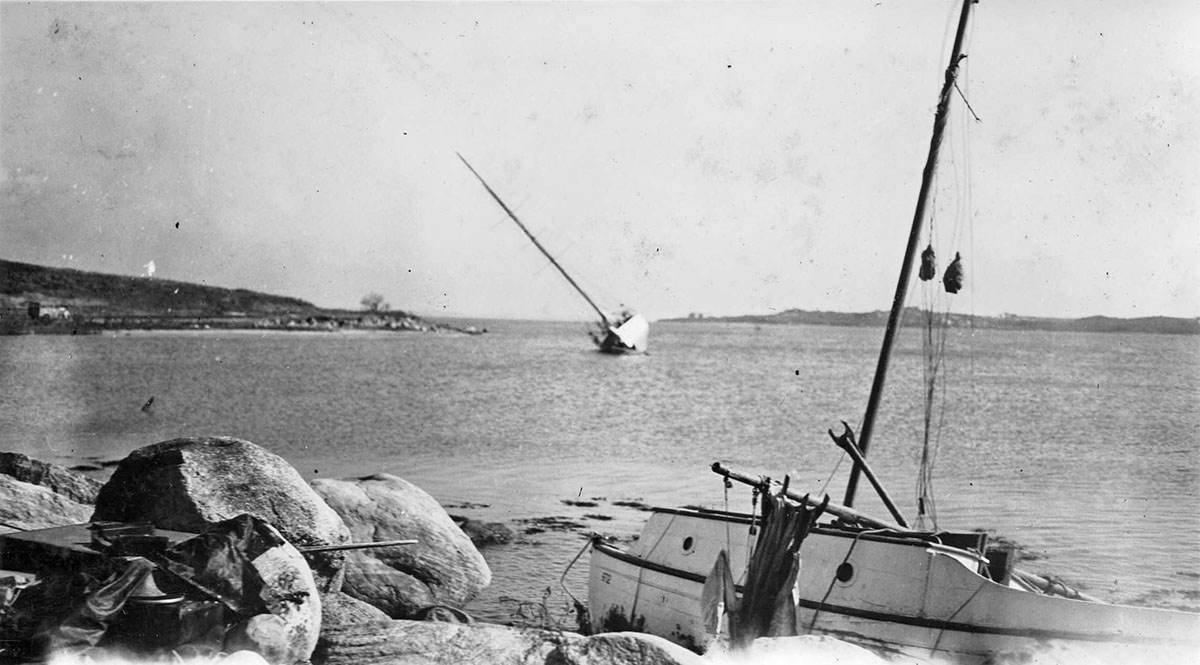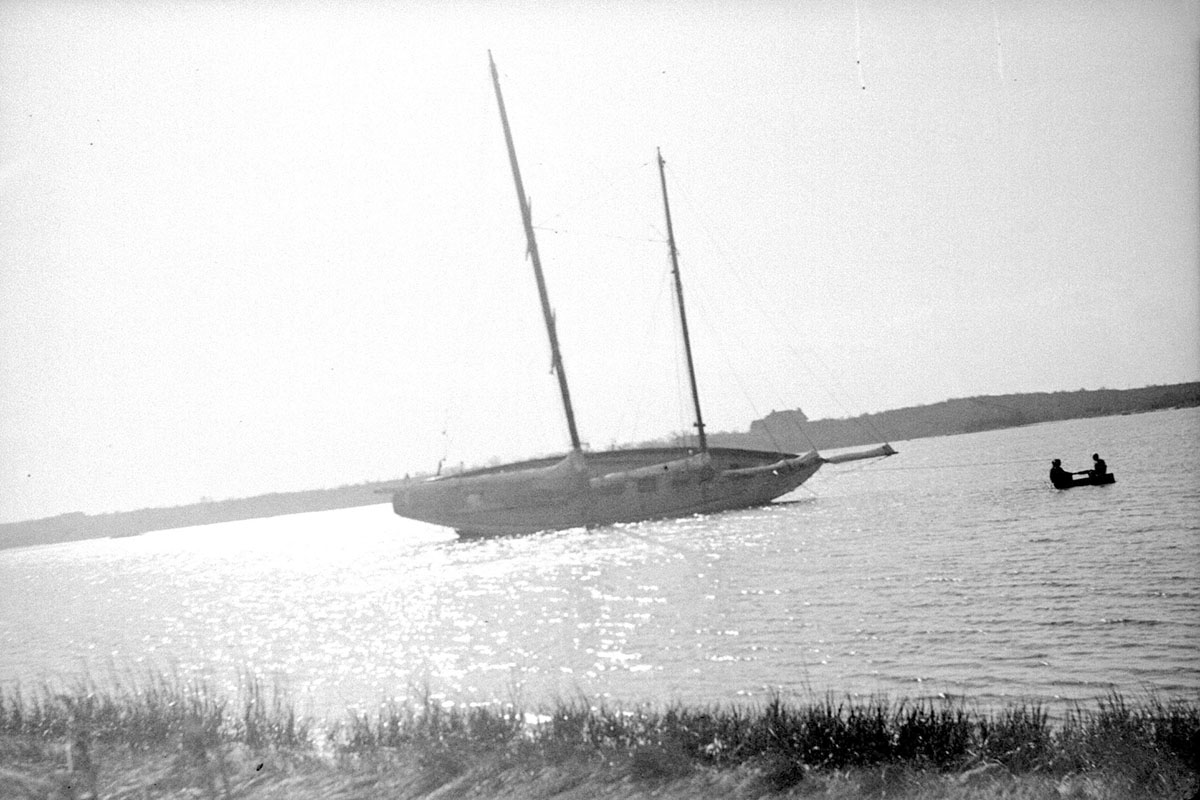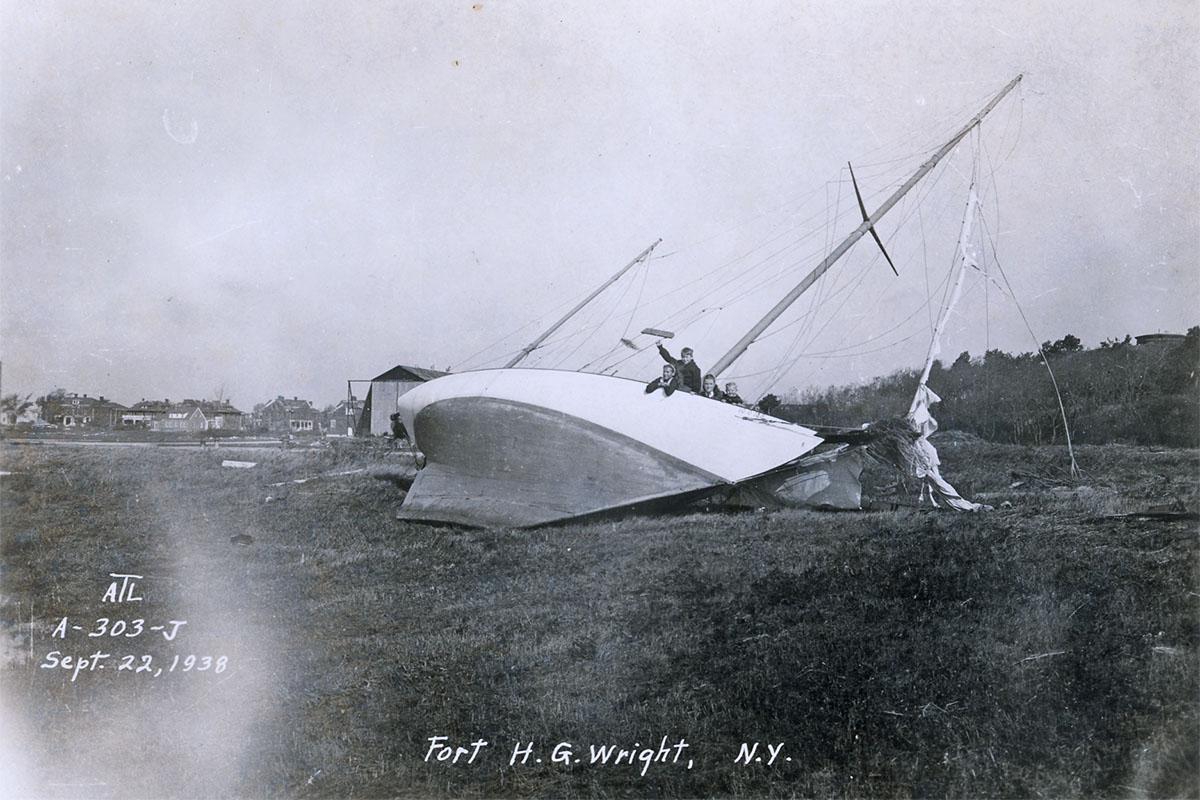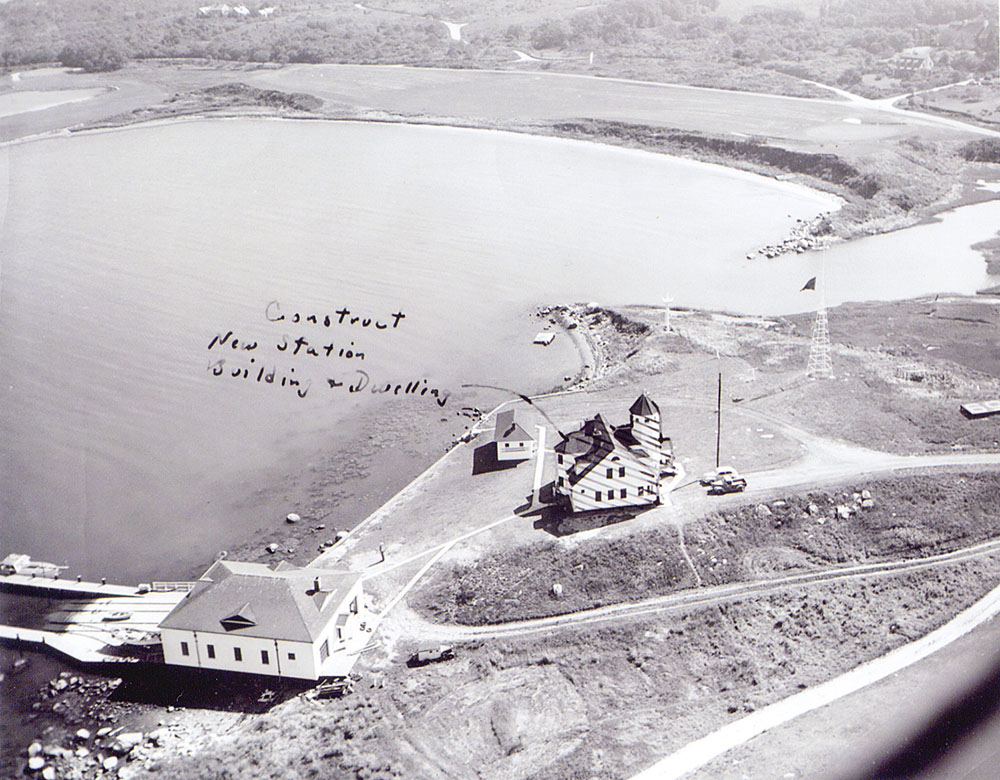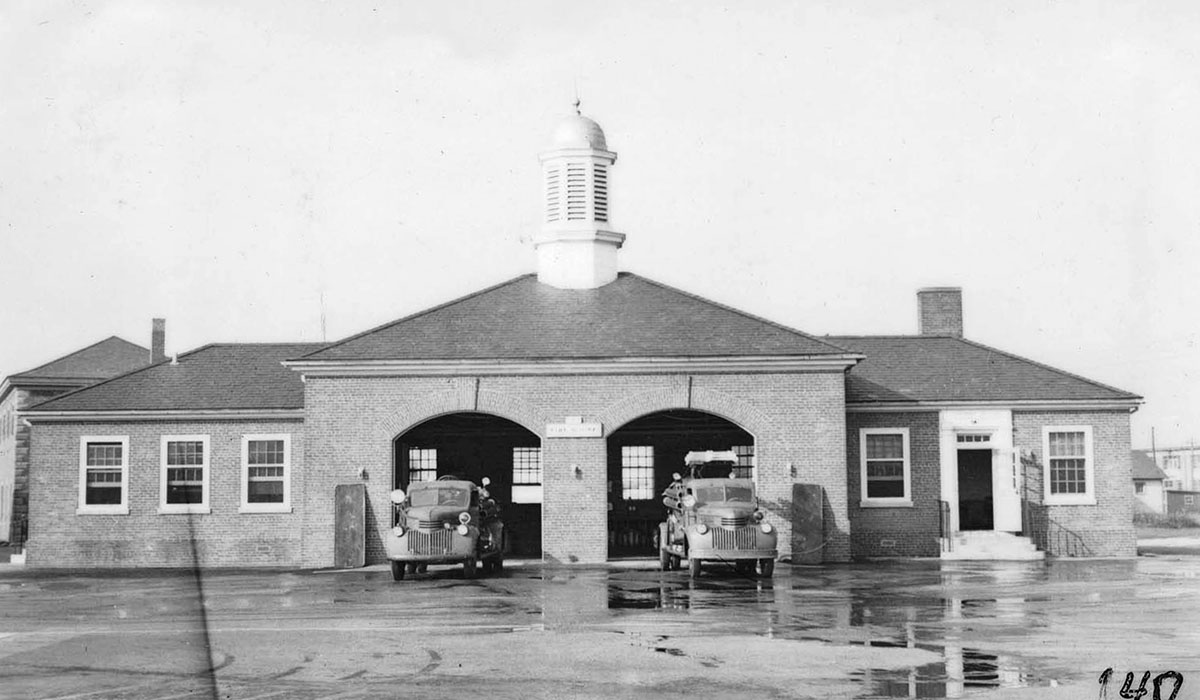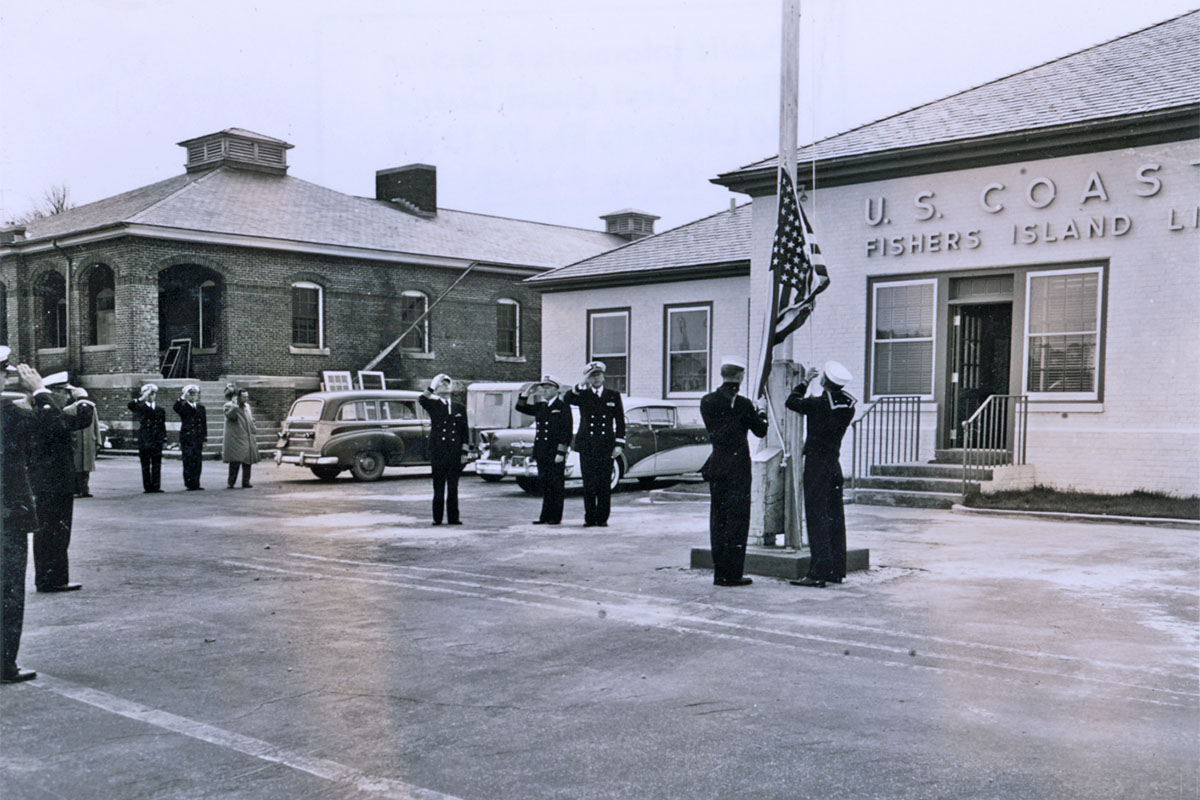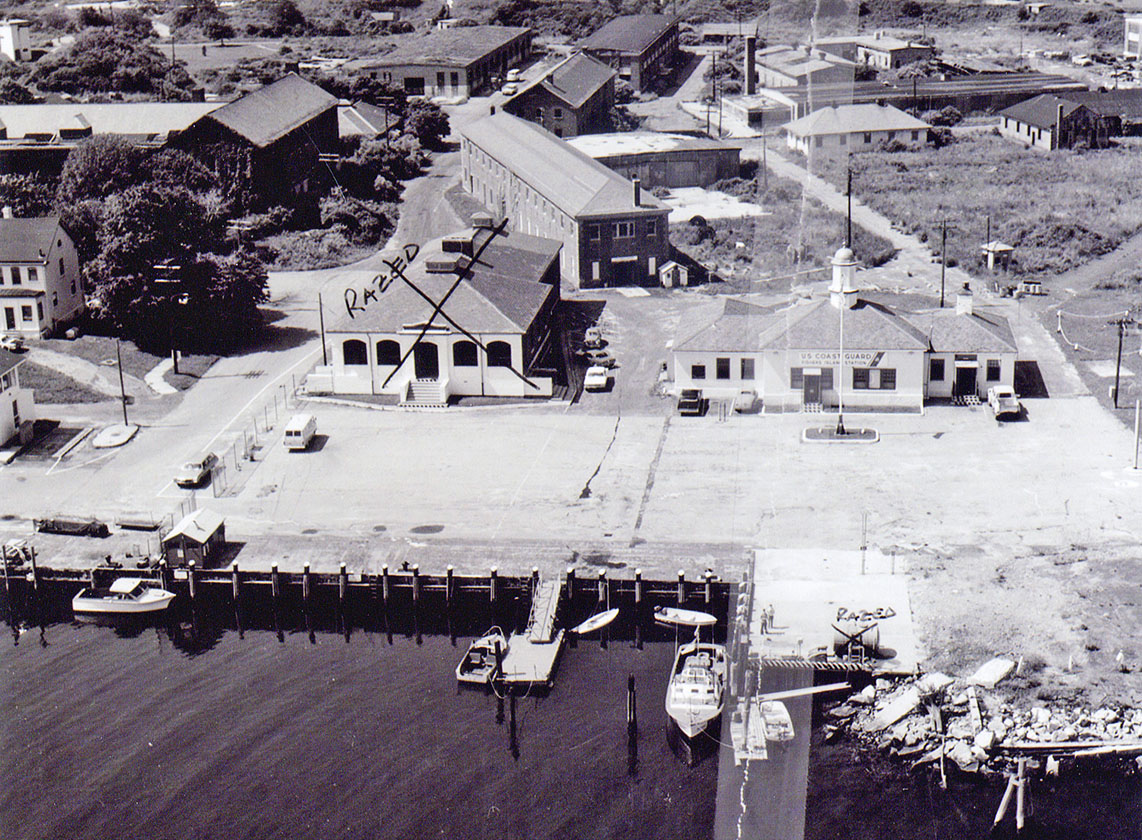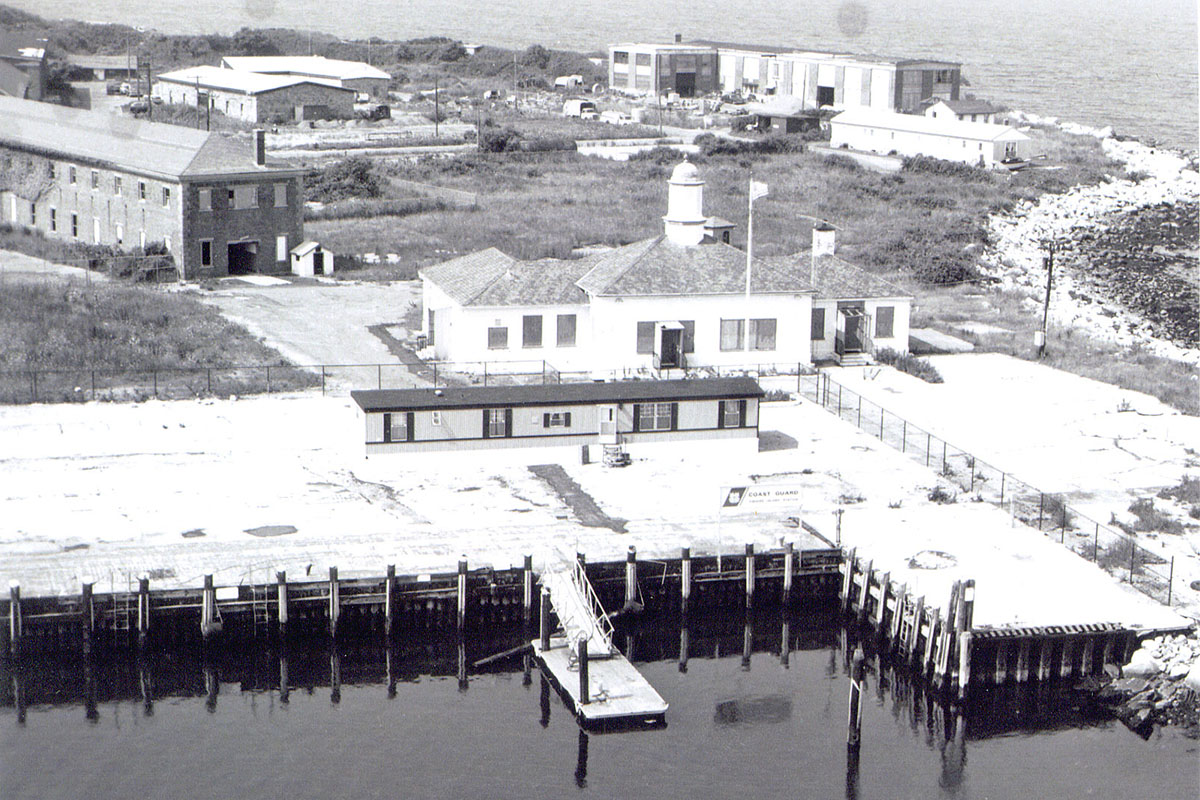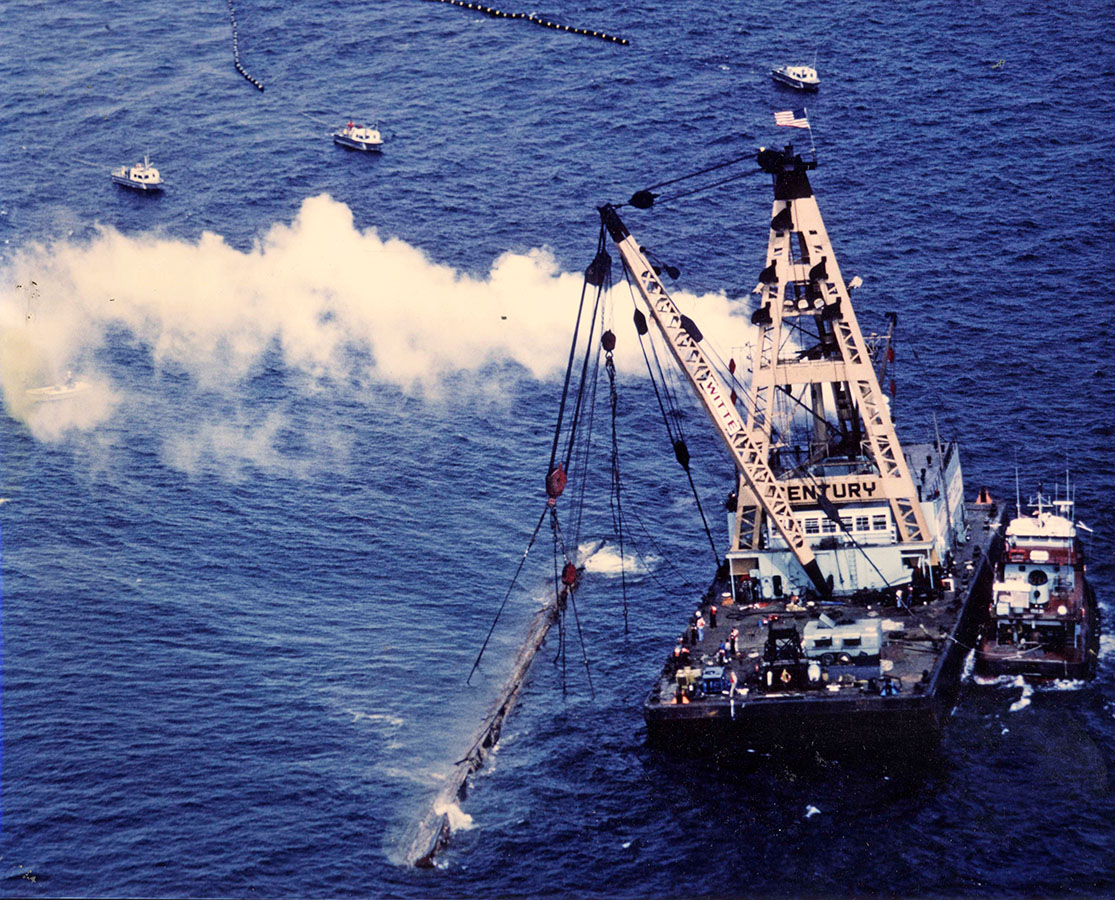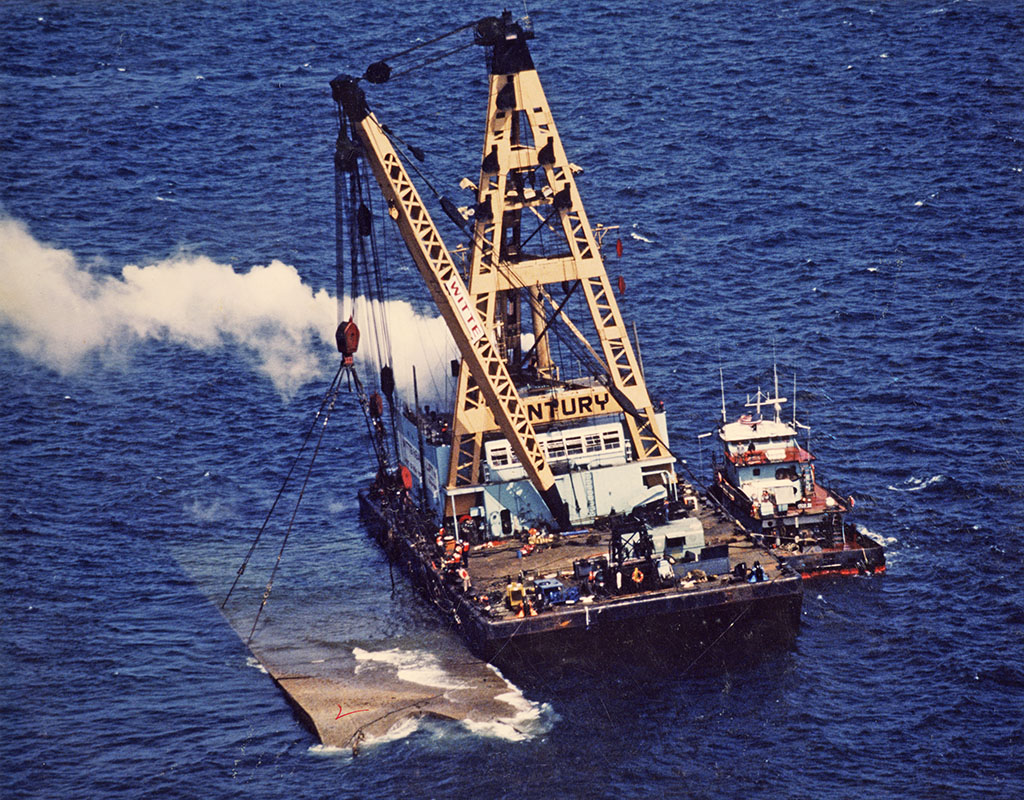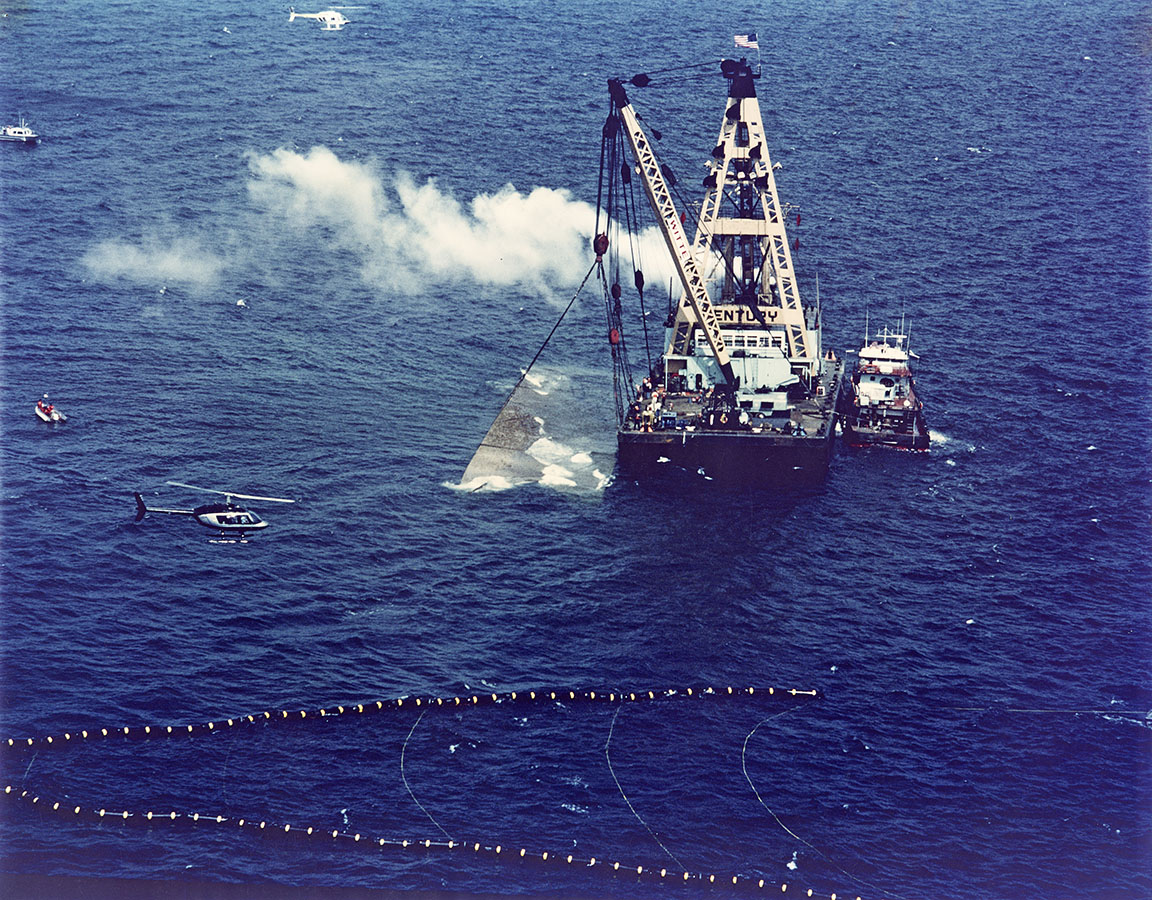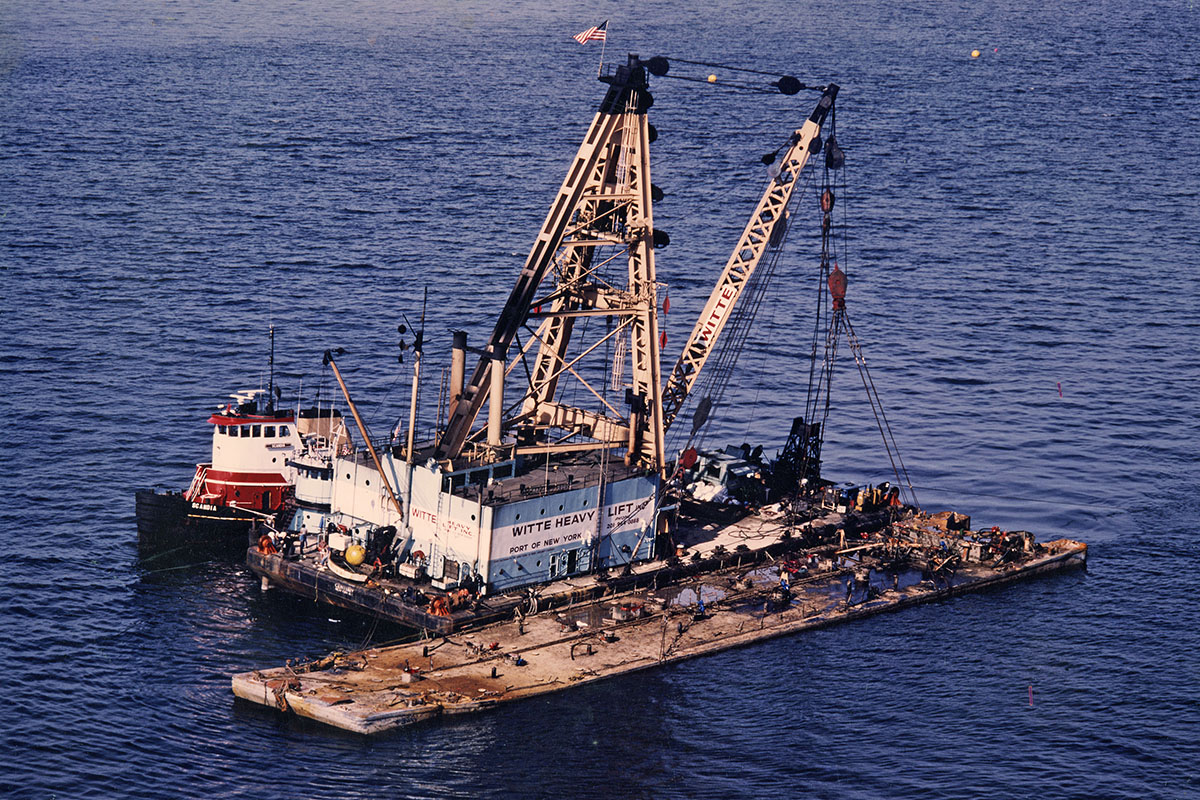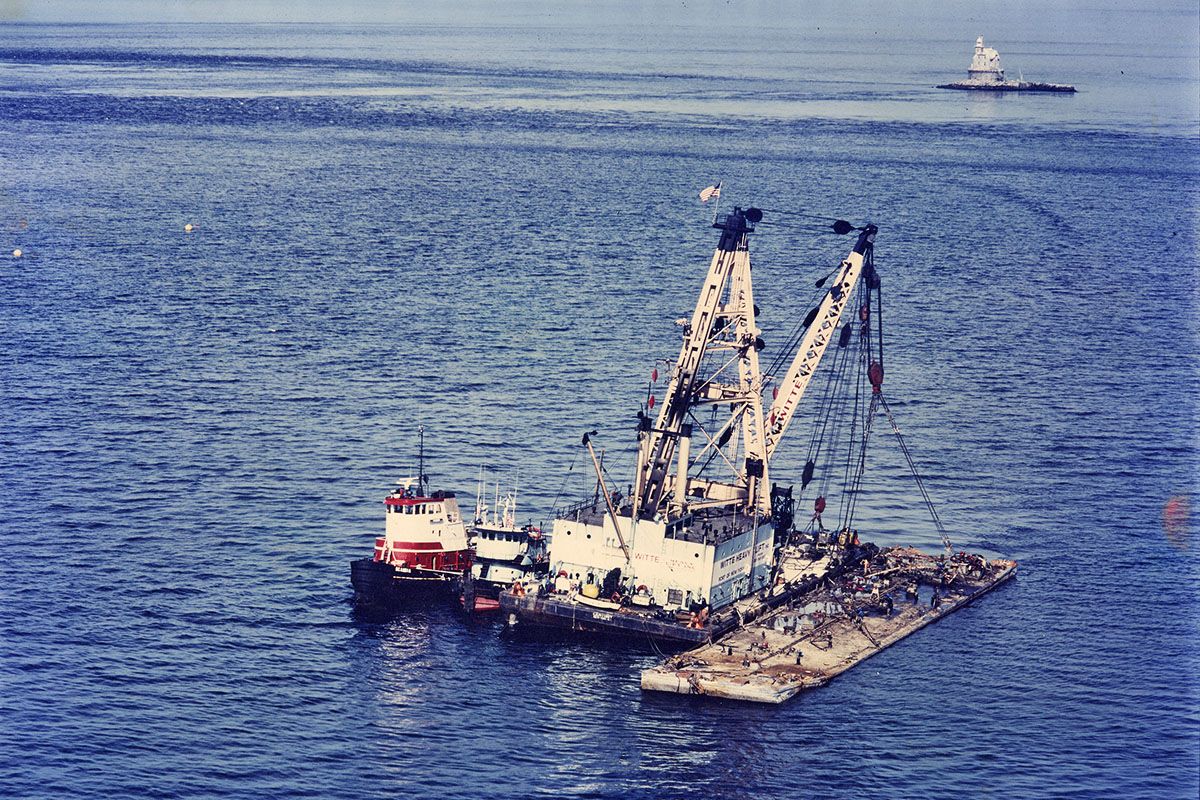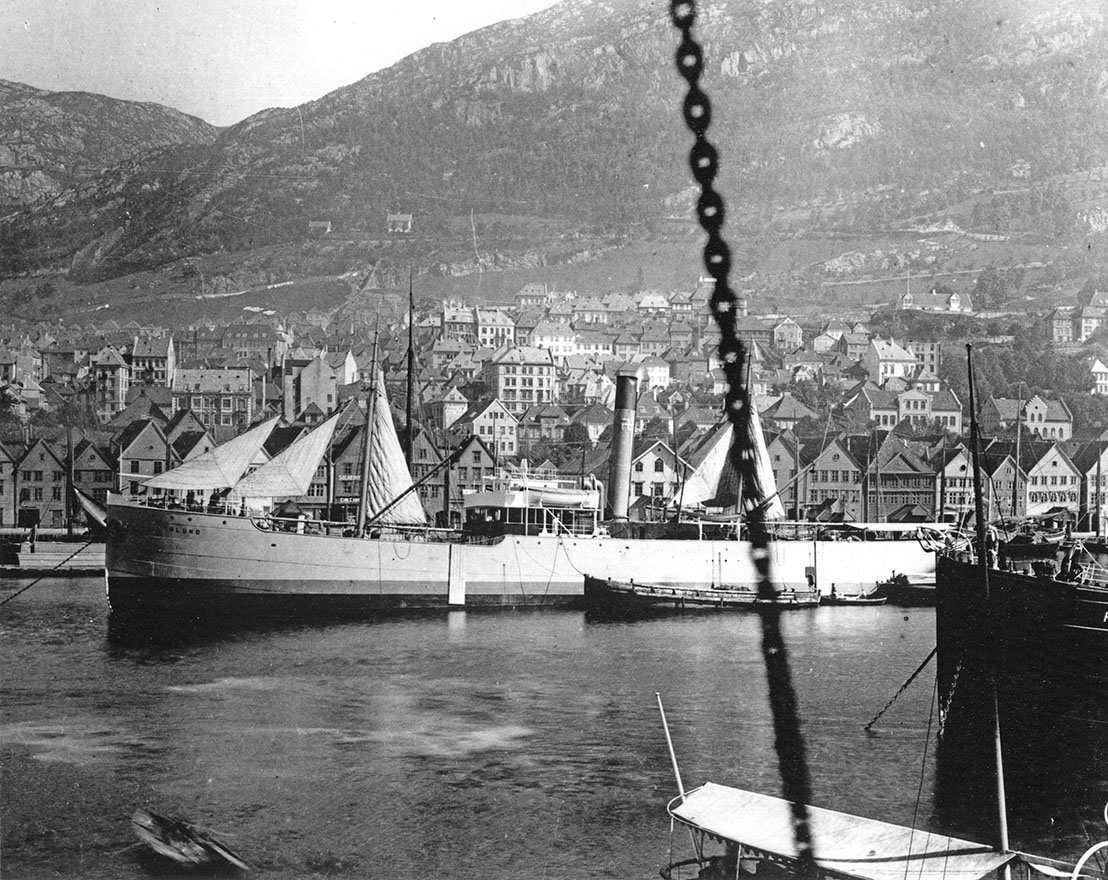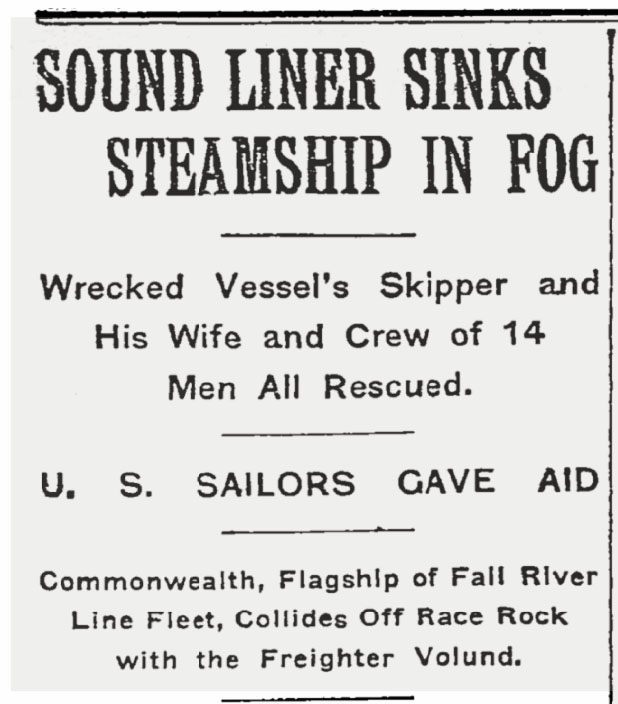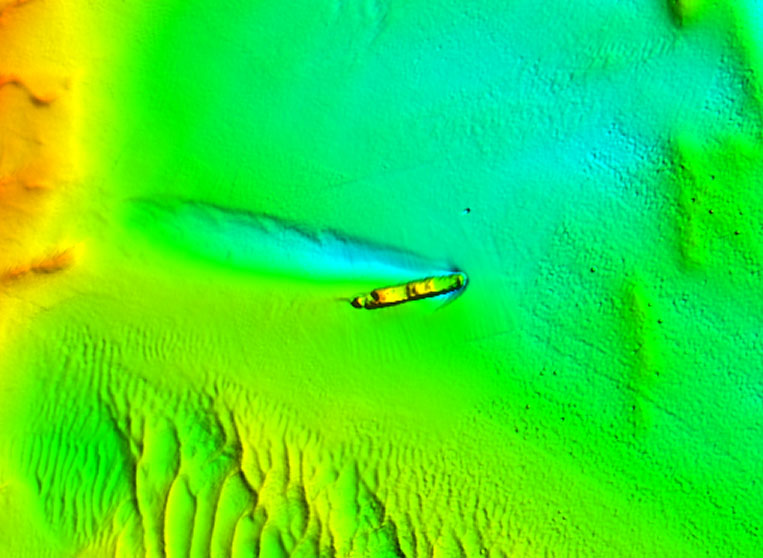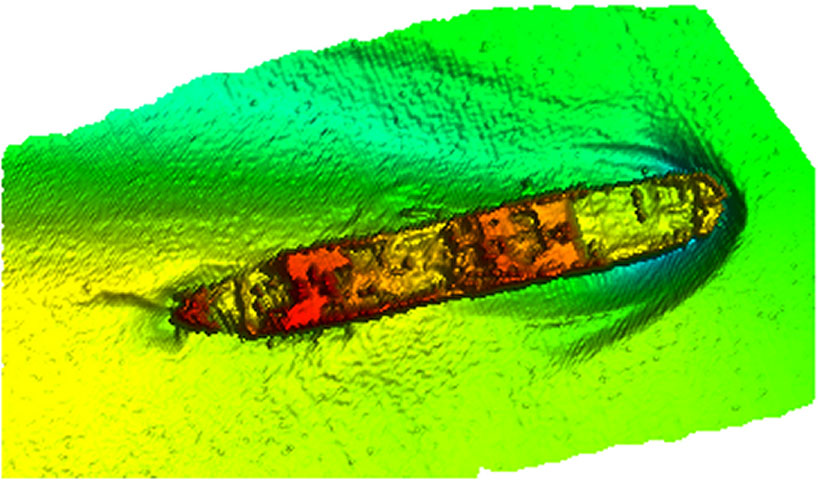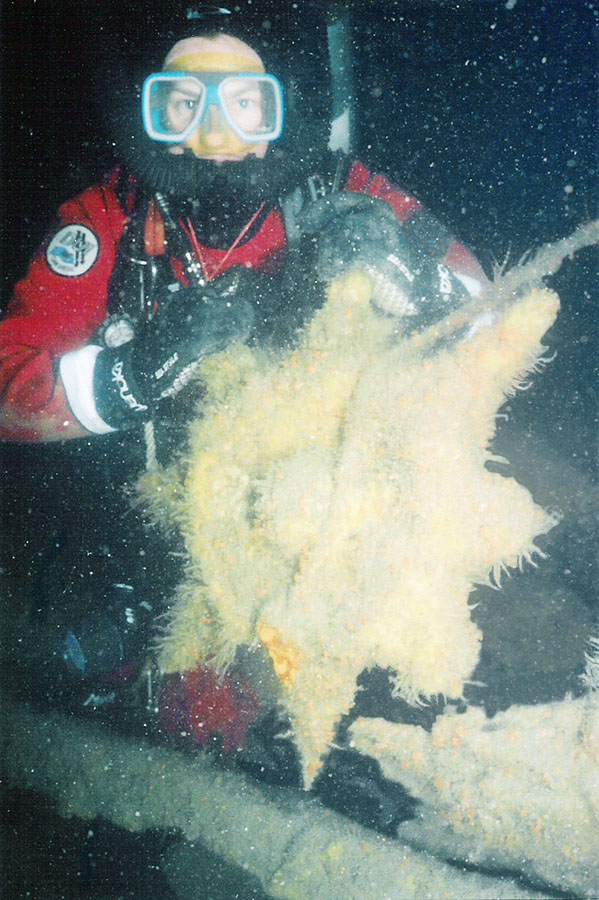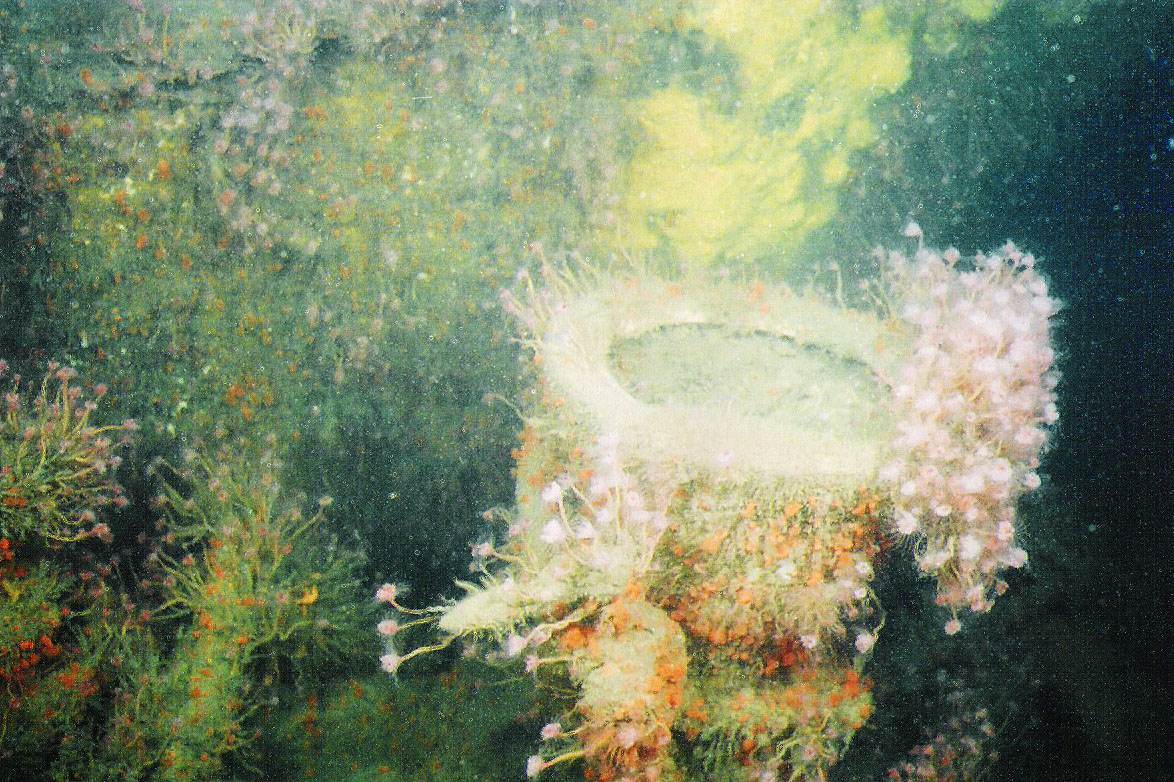ANNUAL EXHIBITION 2006
SHIPS ASHORE!
Wrecks and Rescues on Fishers Island
Curated by HLFM director Pierce Rafferty
Tug Shawanese Ashore Near Silver Eel Cove
April 1911
Copyright Mystic Seaport Collection, Mystic, CT
The tug Shawanese slammed into Fishers Island in the middle of the night on March 30, 1911. The Day reported that the captain, chief engineer, and 12 crew members got ashore in lifeboats through the breakers.
The first recorded shipwreck on Fishers Island occurred on Race Point in 1669. Since that time countless vessels have been cast upon our shores by the elements, human error, or a combination of both. Our location astride the treacherous waters of the Race—the deep water channel that runs between the Island and neighboring Great Gull—makes us a prime wreck and stranding site. Fierce tides, fickle weather, irregular depths, and numerous outcroppings provide ample opportunities for disaster.
Ships have hit on all sides and points of Fishers Island, but the western tip at Race Point and the eastern tip (ocean side) have historically been the most dangerous spots. Many stricken vessels have escaped destruction by floating off with the tide—or by being dragged off in later years by rescue steamers and tugs—but others have not been so lucky. In the 350 years since European settlement, dozens-upon-dozens of stranded sloops, brigs, schooners, steamers, yachts and power boats have been “beaten to pieces” by the sea and reduced to piles of timber or scraps of metal on our rocky shores. The exact human toll is quite difficult to calculate. Approximately 100 people have died in recorded shipwrecks and accidents on or near Fishers Island, with almost half of that figure perishing during the tragic wreck of the steamer Atlantic in 1846.
The 2006 exhibition takes a fresh look at this rich nautical history with a special focus on those who responded to the wrecks and mishaps: the “surfmen” of the US Life-Saving Station on Fishers Island (US Coast Guard after 1915) and the “hard hat” divers of the private salvage companies that plied our waters.
Awful Wreck of the Magnificent Steamer ATLANTIC on Fishers Island
Lithograph by N. Currier
1846
Courtesy of George F. Bass
Crippled by a boiler accident early in the morning of November 26, 1846, the powerless Atlantic was driven by a gale towards Fishers Island, dragging her anchors behind. At 4:30 a.m. on Nov. 27th, the last anchor cable snapped, and she smashed into rocks at the base of North Hill. Approximately 42 of the 78 people on board perished. The exact count will never be known as the passenger log carried on board was lost to the sea.
Lantern Slides Illustrating Life-Saving Techniques
from “The Economic Series”
c.1880s
Copyright Mystic Seaport Collection, Mystic, CT
This series of colored glass slides dramatized the process of firing a lifeline across a shipwreck with a Lyle gun and the subsequent rescue of a man with a breeches buoy. An unmanned wreck station on Fishers Island’s Race Point had similar equipment as early as 1849.
Abandoned Life-Saving Station, Race Point, Fishers Island
1894
Photograph by James S. Casey
Museum Collection. Donated by Polly Edmonds
In response to nautical disasters in the region, including the wreck of the Steamer Atlantic in 1846, the US Congress funded the construction in 1849 of a chain of life-saving stations along the coast of New Jersey and Long Island, including one at Race Point. These simple structures were typically equipped with lanterns, a lifeboat, a metallic “life-car” (seen outside door), and mortars to fire lifelines.
Manned only by volunteers, these early “wreck stations” often suffered from neglect and pilferage. Fishers Island’s Race Point station was rebuilt in the early 1870s, but quickly deteriorated due to the lack of professional care and maintenance. By 1894, the date of the photograph above, the structure was in ruins.
The Loss of the Steamer “C. Vanderbilt”
Illustration from Harper’s Weekly
January 22, 1859
Museum Collection
At 3:45 a.m. on January 3, 1859, the steamship Vanderbilt struck treacherous Race Point and “became fast.” All 100 people aboard were transferred to shore through heavy surf by lifeboat. They found shelter in the unmanned life-saving station at Fishers Island’s western tip. The passengers and crew spent the next day and night huddled inside holding prayer meetings, celebrating their escape, and awaiting rescue. After local farmers successfully arranged transportation to the mainland, the group left their primitive “relief house.”
The “C. Vanderbilt” Ashore on Fisher’s Island
Illustration from Harper’s Weekly
January 22, 1859
Museum Collection
Stranded passengers and crew tramped across the Island to board a hired schooner in Great Harbor (West Harbor) bound for New London. The Vanderbilt, initially predicted to be a total loss, was successfully floated off and repaired at a cost of $80,000.
Capt. T.A. Scott, master diver, wrecker and submarine engineer, moved to New London in 1873 to build Race Rock Lighthouse. After completing that engineering feat, he stayed in New London and established a thriving business salvaging wrecks and rescuing stranded vessels throughout the region. He also built numerous seawalls and docks, including the Munnatawket Hotel dock on Fishers Island.
Capt. T.A. Scott died in 1907, but the business was carried on by his son, Captain T.A. Scott, Jr.
Billhead for Merritt & Chapman Derrick and Wrecking Company
1911
© Mystic Seaport Collection, Mystic, CT
Merritt and Chapman, two independent wrecking and salvage powerhouses on the east coast, merged in 1897 to form the Merritt & Chapman Derrick and Wrecking Co. This New York-based company frequently competed with New London’s T.A. Scott Co. for local wrecking jobs. In 1922, T.A. Scott Co. merged with its rivals, forming the giant concern that was renamed the Merritt, Chapman & Scott Co.
Brig Highlander Aground off South Shore of Fishers Island, NY
c. February 16, 1893
Museum Collection
The Brig Highlander, bound for New York from Cuba, was intentionally grounded on South Beach on February 13, 1893, as she began to sink. The Day reported that the crew of “Cuban Negroes” presented a pitiable sight hobbling about on the beach. Suffering from frostbite and exposure, they were taken by the S.S. Munnatawket to New London for treatment.
Wrecking Barge Unloading Stranded Brig Highlander, South Beach, Fishers Island, NY
c. February 16, 1893
Courtesy of Paul Morris
T.A. Scott wreckers managed to save the cargo of mahogany, but the stranded brig soon broke up in heavy seas. Note the E.M. Ferguson (later Pendleton) house on right and the Sanford house (today Yonce) in center between the two vessels.
The Steamer Olinda Hard Aground on Fishers Island
June 1895
Photograph by James S. Casey
Museum Collection. Donated by Pierce Rafferty
When the 250-foot Portuguese steamer Olinda plowed into Fishers Island’s south shore on June 11, 1895, she was the largest steamer ever to run aground in this vicinity. Initially stable in moderate weather, she attracted thousands of tourists who boarded her from excursion boats and purchased discounted wine by the bottle from stranded crew. Despite this diversionary merriment, almost all of the cargo was saved, including 2,000 bales of cork wood, 800 empty petroleum barrels, nineteen bags of cocoa, and one case of perfumery.
The Steamer Olinda Halfway to a Watery Grave
July 1895
Museum Collection. Donated by Harry and Susie Ferguson
By late June, large waves were breaking over the wreck and Capt. Thomas A. Scott, the wrecker in charge of the salvage attempt, was forced to abandon all efforts to pull her off the rocks. She broke in two during mid-September storms.
Propeller Tillie Ashore at Fishers Island
c. August 1, 1896
Courtesy of Paul Morris
Laden with sardines, the 147-foot Tillie (center background) stove in her hull on rocks mere yards from the protruding bow of the sunken steamer Olinda. A wrecking barge is featured at left. The Tillie was successfully hauled off by the Merritt Wrecking Company. Please note that the vessel was renamed on this photo by someone with a juvenile sense of humor.
Note that the S.S. Olinda is in two sections in center and right foreground with her sunken bow protruding at right. The wreck is still visited by scuba divers today, but her steel hull has broken up and has been largely dispersed by more than 100 years of tides and storms.
In 1967, passenger and auto ferry M/V Olinda, without doubt one of Fishers Island’s smallest and most intrepid ferries, was contradictorily named for this cumbersome, unlucky, sunken steamer. The sixth hole at the Big Club’s golf course, overlooking the wreck site, also bears her name.
The US Training Ship Hartford Aground on Race Rock Ledge
c.1900
Museum Collection
The circumstances and date of this nautical accident are unknown, but the distinguished military record of the USS Hartford is well chronicled; she was the flagship of Flag Officer (later Admiral) David G. Farragut, who reportedly shouted “Damn the torpedoes, full speed ahead!” while lashed to her masts during the Battle of Mobile Bay in 1864.
This photograph indicates that the vessel once celebrated for moving ahead against all odds met its match in the Race. The Hartford was launched in 1858, rebuilt in 1899, and measured 305 feet in overall length.
Steamboat City of Worcester Half Sunk in New London Harbor
May 29, 1898
Courtesy of Paul Morris
After hitting Cormorant Reef in Fishers Island Sound, the steamboat City of Worcester attempted to limp into New London Harbor but sank short of her goal. After the passengers were rescued, T.A. Scott Company crews began to pump her out. She was refloated within the week.
Tug Shawanese on Her Beams at Fishers Island
April 1911
Museum Collection
On the night of March 30, 1911, the 121-foot tug Shawanese with three barges in tow hit hard on Fishers Island’s coast 1/8th mile east of Silver Eel Pond. Wreckers from T.A. Scott Co. succeeded in floating the barges, but due to rough seas, it took more than a week to raise the 199-ton tug.
Rescue Steamer Relief in Heavy Seas
c.1910s
Courtesy of Paul Morris
The Relief, a 184-foot deep-sea rescue steamer, was launched in 1907 at Wilmington, Delaware, for the Merritt & Chapman Wrecking and Derrick Co. A frequent participant in salvage work in our waters, she hauled the 371-foot freighter City of St. Louis off the rocks on Wilderness Point in the mid-1930s.
Note the galloping black horse on the stack. This symbol was long associated with Captain Merritt and became the house flag of Merritt & Chapman after their merger in 1897.
Tug Pulling Schooner from Rocks Isabella Beach, Fishers Island, NY
August 21, 1914
Photograph by Edward Quimby
Museum Collection. Donated by Pierce Rafferty
The Schooner Flora Condon drifted onto rocks at Isabella Beach and stranded with no hope of getting off with the tide. The 109-foot T.A. Scott wrecking steamer Tasco pulled the schooner afloat and took her under tow to New London. The charge: $300.00.
Steam Yacht Warrior on the Rocks at Race Point
July 19, 1916
Museum Collection. Donated by Bunty Armstrong
Fog was blamed for the accident that put the Warrior ashore 1000-feet west of Silver Eel Pond. She was cruising at 12 knots when she crashed into large boulders. The Day reported, “Wireless calls of distress were sent out by the yacht’s operator. They were answered by a fleet of tugs and wrecking apparatus…” She was pulled free on high tide by tugs Harriet, Westerly, Paul Jones, and mine planter General S. M. Mills.
NY Evening Telegram Headline
July 19, 1916
© Mystic Seaport Collection, Mystic, CT
Built for F.W. Vanderbilt, the Warrior had recently been purchased by Mr. Alexander S. Cochran, who was on board with members of the von Stade and Hitchcock families at the time of the accident. All escaped injury and were carried by launch to New London.
The Evening Telegram article reported that the Warrior was one of the New York Yacht Club’s largest yachts. “She was built at Troon, Scotland, and was launched in 1904. She is 282-feet long, 32 feet beam and has a draft of 14.3 feet. She has two decks and is built of steel.”
Merritt & Chapman “Hard Hat” Divers on the Monarch
c.1917
Courtesy of Paul Morris
This unusual group portrait features 21 divers of the Merritt & Chapman Derrick & Wrecking Co. posing on the deck of the derrick barge Monarch. These faceless heroes were expected to perform complex underwater explorations and engineering feats in all types of weather.
In 1904, the US Life-Saving Service established a life-saving station on the west side of East Harbor (today’s Campbell residence). The main structure initially housed a paid crew of six experienced surfmen with an extra man added for the harsh winter months.
US Life-Saving Service Crew, Fishers Island, NY
c.1910
Photograph by Lawrence D. Goodell.
Museum Collection. Donated by Pierce Rafferty
The crew of the Fishers Island Life-Saving Station first reported for duty on Thanksgiving Day, 1904, the 58th anniversary of the wreck of the Steamer Atlantic. New London’s The Day stated that “had a life saving station been established like the one at the present time…every life on the ill-fated steamer would have been saved.”
US Life-Saving South Shore Boathouse, Fishers island, NY
c.1908
Photograph by Lawrence D, Goodell. Donated by Pierce Rafferty
The Life-Saving Station was purposefully built on the narrow neck of the island to allow surfmen access to both the north and south shores. The secondary boat house shown here was located on the eastern section of what is today Club Beach.
Surfman on Shore Patrol, Fishers Island, NY
c.1910s
Museum Collection. Donated by Harry and Susie Ferguson
At night and in bad weather, the surfmen of the Life-Saving Station patrolled assigned sections of the north and south shores of Fishers Island carrying a patrol clock. At the end of the route there was a post with a patrol-clock key attached. By turning the key in his patrol clock, a surfman was able to prove that he had covered his assigned territory within a specific timeframe.
This surfman is carrying a Costan signal around his neck. Similar to flares, they were used to signal stranded or wrecked vessels and to warn ships from straying too close to shore.
Launching a Surf Boat, Fishers Island, NY
c.1915
Museum Collection
Part of the crew’s weekly routine was to practice launching and landing their surf boats. To simulate emergency conditions, they capsized the boats intentionally and then righted them. It was difficult and dangerous work. Surfman Howard B. Pollard died while launching a surfboat on Fishers Island on May 24, 1929.
Group Posing by a Lifeboat, Fishers Island Life-Saving Station
c.1910
Museum Collection. Donated by Jim Righter
The Dobbins lifeboat seen here weighed approximately 1,800 pounds, was approximately 27-feet in length, and, according to a promotional catalogue, was “strong, portable, self-righting and self-bailing, and literally unsinkable.”
US Life-Saving Crew Practice, Lyle Gun Fishers Island, NY
c.1910s
Photograph by Lawrence D. Goodell
Museum Collection. Donated by Pierce Rafferty
One day each week the crew practiced and drilled with their beach equipment. In this photo they are firing a heavy line to a simulated wreck with a Lyle Gun. The target is the practice pole in the background which is designed to look like a mast.
US Life-Saving Crew Practice, Breeches Buoy Fishers Island, NY
c.1910s
Photograph by Lawrence D. Goodell
Museum Collection. Donated by Pierce Rafferty
At this stage of the drill, the line shot to the “wreck” by the Lyle gun has been attached to the “mast” and the crew is racing back into position to haul the man to shore in a breeches buoy, which has been aptly described as “a life preserver ring with canvas pants attached.” The rescued man can be seen dangling from the ropes in left center background.
The crews practiced these drills relentlessly. During inspections, failure to perform within proscribed time limits was grounds for dismissal.
The US Life-Saving Station on East Harbor, completed in 1904, became a US Coast Guard Station in 1915 when the Revenue Cutter Service merged with the U.S. Life-Saving Service and was officially renamed the US Coast Guard at that time. With the onset of Prohibition in 1920, the Coast Guard Station on Fishers Island was soon drawn into a multi-year struggle to intercept and control illegal alcohol smuggling in our waters.
The rumrunner Thelma Phoebe ashore on Chocomount Beach, Fishers Island, NY
circa April 29, 1923
Museum Collection
The 157-ton steam yacht Thelma Phoebe came ashore on April 29, 1923, in the midst of a classic sou’easter. Seven members of the crew reached the beach on a life raft, but the black cook, Isaac Roberts, drowned in the surf and is buried on the island in an unmarked grave at St. John’s Cemetery No.1.
Coast Guard and Customs agents boarding Thelma Phoebe, Chocomount Beach, Fishers Island, NY
circa May 2, 1923
Courtesy of Bob Brooks
The Thelma Phoebe carried 2,400 cases of prohibition-era Scotch that quickly drew the attention of hundreds of island residents, soldiers from Fort Wright, and the authorities. Coast Guard and Customs agents managed to secure hundreds of the cases, but countless bottles and cases were “rescued” by islanders from the surf and the shoreline immediately after the wreck.
Coast Guard standing over confiscated liquor from the wrecked rumrunner Thelma Phoebe, Fishers Island, NY
circa May 1, 1923
Museum Collection. Donated by Harry and Susie Ferguson
Coast Guard surfmen and U.S. Custom officials guarded the wrecked rumrunner day and night for over three weeks to keep the citizens of Fishers Island and the soldiers of Fort H.G. Wright at bay until the valuable cargo was completely unloaded and the surrounding area was cleared of stray cases and bottles. On several occasions, armed guards were forced to brandish weapons to dissuade those wishing to seize the liquor.
Custom House, New London, Connecticut
Postcard courtesy of the New London Maritime Society
The seized alcohol from the Thelma Phoebe was stored at the Custom House on Bank Street in New London. Eventually, after a legal hearing, all the confiscated alcohol was released back to representatives of the ship owner because the British-registered ship had papers documenting a route between Nassau and Halifax, two British ports where the import and export of alcohol was legal. The disposition of the balance of cases remains an island mystery. Some were lost to the sea, but a great number “disappeared” on island.
Rumrunner Bali ashore on Fishers Island, NY
May 31, 1932
Museum Collection. Donated by Richard Baker
Early on the morning of May 31, 1932, the Bali, out of Bridgeport, Conn. went hard aground on Fishers Island at the western end of Chocomount Beach. A search of the vessel by Coast Guard surfmen turned up seven sacks, each containing 24 pints of liquor. An additional 109 sacks were later located in the waters alongside the vessel. The three crew members, who refused to give their names, were taken by Coast Guard patrol boat to New London for further interrogation.
Wrecked rumrunner Barbara, Fishers Island, NY
circa March 19, 1925
Museum Collection. Donated by Paul Bates
Early on the morning of March 19, 1925, the motor boat Barbara ran ashore on the rocks west of Chocomount Beach. She was carrying 243 cases of whiskey. The Coast Guard log reveals “it was necessary to have a strong guard through the night to prevent soldiers from Fort Wright from boarding the vessel.” Those who arrived were kept away from the whiskey by a “show of arms.”
The vessel was a total loss, but a wrecking company salvaged the engine after two days of difficult work in the heavy surf.
Detail of map marked by head of U.S. Coast Guard Station, East Harbor, Fishers Island, NY to show location of assists and rescues made by Coast Guard from 1920 to 1935
Map published by US Coast and Geodetic Survey, 1882 with additional markings by Capt. C.E. Peckham
Museum Collection. Donated by Harry and Susie Ferguson
Please note the marked location of five clustered rumrunner wrecks. The Bali hit shore just west of Chocomount Beach; La Mascotte IV ran aground just east of that location; the Thelma Phoebe wrecked in the middle of Chocomount Beach; the Barbara went aground just east of Chocomount Beach near Barley Field Cove; and the Columbia came to rest just east of that position on the Barley Field Cove Reef.
Remarkably, all five wrecked in close proximity to each other. While the Thelma Phoebe was driven ashore by a storm, the others hit land at night, likely running without lights as they headed toward the mainland from Rum Row. Another possibility is that some of these boats were intent on offloading cargo on Fishers Island.
Wreck of the Schooner Viking
1925
1st & 4th image, Museum Collection
2nd image, Courtesy of Helen Best family
3rd image, Courtesy of M.L. Gaillard
The Noank-built fishing schooner Viking was bound for New York from New Bedford filled with 15,000 pounds of flounder when she went ashore just west of Isabella Beach in a heavy fog on March 18, 1925. The severely damaged vessel was abandoned to the elements with only the engine saved. The beach where the wreck occurred is still sometimes referred to as “Viking Beach.”
Freighter Willboro Aground on Race Rock
March 26, 1936
Courtesy of N.Y. Daily News
This 414-foot freighter was laden with 450,000 feet of lumber when she piled onto Race Rock in a thick fog, almost broadsiding Race Rock Light. After a series of failed attempts to float her, enough cargo was unloaded that five rescue vessels working together succeeded in dragging her off the rocky ledge as she churned her powerful engines in reverse.
Steamer City of St. Louis on Wilderness Point, Fishers Island, NY
April 13, 1938
Photograph by Adelard T. LeGere
Museum Collection
After plowing into the south shore of Fishers Island in a thick fog on April 13, 1938, the 371-foot Steamer City of St. Louis (Savannah Line), remained stuck on the rocks of Wilderness Point for nine days. She was reported to be leaking badly “fore and aft.”
Steamer City of St. Louis on Wilderness Point
April 13, 1938
Courtesy of N.Y. Daily News
The Day reported that “blasts from the steamer’s whistle as she went aground brought many Fishers Island residents to the scene as sightseers.” One group of voyeurs is standing on the hill overlooking the stranded vessel. Please note the Porter residence at top center, and Wilderness Dairy at top left. Note also the narrow road that used to traverse the bluff’s edge along the south shore in this section of the island.
Close view of Steamer City of St. Louis on Wilderness Point
April 20, 1938
Museum Collection
While the City of St. Louis was stuck on the rocks, water was pumped from the holds, much of the cargo was removed, and the hull was patched. At 1:30 a.m. on April 22nd, the Merritt, Chapman & Scott rescue vessel Relief succeeded in pulling the steamer off the rocks.
In the wake of the 1938 Hurricane, scenes of wrecked and stranded boats ashore on Fishers Island, like the ones seen below, proved popular with shutterbugs.
Stranded Boat on Yacht Club Dock, Fishers Island, NY
September 22, 1938
Photograph by Adelard T. LeGere
Museum Collection. Donated by Alexander Gaston
Taken the day after the 1938 Hurricane, this photograph shows a motor vessel owned by the Lamborn family perched almost comically on the yacht club dock. During the storm, the boat had floated up to the top of the dock and remained stranded there after the tidal surge receded.
Yacht Barlovento (in background) Beached on Sandbar at Hawk’s Nest Point, West Harbor, Fishers Island, NY
September 22, 1938
Museum Collection. 2013 Acquisition
This photograph, taken the day after the 1938 Hurricane, documents the stranded state of the legendary 64-foot auxiliary schooner Barlovento, owned by Pierre duPont III.
Children Posing on Sailboat Tossed Ashore During the 1938 Hurricane, Fishers Island, NY
September 22, 1938
Photograph by Adelard T. LeGere
Museum Collection. Donated by Jim and Diane Baker
This boat, with sailors still on board, was deposited just south of the Balloon Hangar, east of the Parade Grounds, Fort H.G. Wright. Note on reverse in ink: “This boat was in the water & landed on Ft. Wright field.” Luckily there were no known serious injuries.
Another New Island Is Formed
September 21, 1939
Museum Collection. Donated by Harry and Susie Ferguson
When the tidal surge swept over the western end of the Big Club’s golf course, it submerged the 1st, 2nd, 14th, 15th, 16th, 17th and 18th holes, amongst others. The wind-driven sea flowed into East Harbor on both sides of the Coast Guard Station, creating a new island that held only the Coast Guard Station and its Boat House (seen here).
Fort H.G. Wright Firehouse, Silver Eel Pond
c.1948
Museum Collection. Donated by Tom Baker
This building (later the Ferry Annex and then Lighthouse Works) functioned from 1941 until 1949 as the Fort H.G. Wright firehouse. It was put on caretaker status in 1949 after the fort was shuttered. In 1956 it reopened as a Coast Guard Station.
US Coast Guard Station, Silver Eel Cove, Fishers Island, NY
c.1956
Museum Collection. US Coast Guard Photograph
In 1956, the Coast Guard finally abandoned their aging wooden station on East Harbor and established their new station in the former Fort Wright firehouse overlooking Silver Eel Cove. After months of remodeling, the former firehouse was officially commissioned on October 26, 1956.
Please note the former Fort Wright jail at left that was razed in 1975.
High shot of former US Coast Guard Station, Silver Eel Cove, Fishers Island, NY
c.1980s
US Coast Guard Photograph. Museum Collection
Beginning in 1975, the Coast Guard began operating seasonally on Fishers Island, abandoning the post each fall and returning in the spring. During this transition period, the Coast Guard moved out of its permanent brick station house into a temporary trailer on the adjacent lot facing Silver Eel Cove. (The exact date for the abandonment of the permanent station house has not been determined.)
US Coast Guard Station, Fishers Island, NY
September 10, 2013
Photo by Petty Officer 2nd Class Jetta Disco
U.S. Coast Guard District 1 PADET New York
Circa 1990, the modular house seen here replaced the temporary trailer that had been utilized on the same site. The house became the Coast Guard’s seasonal (“small”) search and rescue post on Fishers Island, housing four-member crews on a rotating basis.
Today the station on Fishers Island has no assigned crew and is in the process of being phased out as redundant. The Coast Guard’s primary argument is that search and rescues undertaken near Fishers Island can be staged in a timely manner from mainland bases at considerably less expense. When the station finally shuts down, a tradition of more than a century of island-based US government rescue and life-saving efforts will come to an end.
Thank You
The Museum would like to thank the co-sponsors of the 2006 exhibition: Altus Partners, Inc., a risk management and insurance brokerage firm founded by Charles Wilmerding in 1997, and Chubb, an insurance concern with long ties to the Fishers Island community. Their generosity is much appreciated by all. In addition, we would like to thank the following individuals and institutions for their assistance: The anonymous diver who donated a fork from the wreck of the steamer Atlantic; Ivar Babb, director of the National Underwater Research Center at UConn’s Avery Point campus, for providing bathymetric images of the sunken Volund; Dr. George F. Bass, for sharing research and his Currier print of the wreck of the steamer Atlantic; Dr. Frank Bohlen, for his general assistance; Claus Guglberger, Daily News Pix; Jeff Godfrey and Scott Annis for sharing their images of the Volund; the late Paul Morris, who provided many of the T.A. Scott Co. photographs; Mark Munro, diver, for creating the short movie on the wreck of the Volund and for helping in many ways; Amy German, Bill Peterson, Wendy Schnur, and Louisa Watrous of Mystic Seaport, and all of their staffs, for helping with research at the G.W. Blunt Library and the Historic Photography Collection, Mystic Seaport, Mystic CT.; Mark C. Mollan, Archivist, NARA, Washington, D.C. for his dedicated research; Bagley Reid, for providing Josiah Bartlett’s oil painting; Scott Reid for his thoughtful support; the staff of the U.S. Coast Guard’s Historian’s Office, Washington, D.C.; John Wilton, for his great work printing all the photographs on display; and Wick York, for patiently answering questions on the intricacies of life saving.
We couldn’t have done it without you!
*Please note: Some artwork, artifacts, and photographs referenced in the acknowledgment section above were not included in this virtual exhibit.
The digitizing of this 2006 Exhibition for online viewing has been made possible thanks to a generous grant from the Jeanann Gray Dunlap Foundation.
ADDENDUM
On November 22, 1985, a 240-foot barge sank in 185 feet of water south of the western tip of Fishers Island while carrying 840,000 gallons of oil. Six months later, the US Coast Guard succeeding in raising the sunken barge with its cargo still intact and moved it to shallow water closer to Fishers Island for repairs and salvage.
Barge E-24 Recovery Operation, Near Fishers Island, NY
May 1986
US Coast Guard Photograph
Museum Collection. Donated by Alexander Gaston
On November 22, 1985, a 240-foot barge sank in 185 feet of water south of the western tip of Fishers Island while carrying 840,000 gallons of oil. Six months later, the US Coast Guard succeeding in raising the sunken barge with its cargo still intact and moved it to shallow water closer to Fishers Island for repairs and salvage. The derrick barge Century, seen here lifting the barge, had a 500-ton lifting capacity.
SS Volund at Unidentified Port
c.1905
Courtesy of Scott Annis
This 239-foot Norwegian tramp steamer sank in the Race southwest of Fishers Island after being rammed by the passenger steamer Commonwealth on September 26, 1908. Thick fog and excessive speeds were blamed for the accident. The Volund sank just minutes after the collision with all crew and passengers pulled to safety aboard the Commonwealth.
Bathymetry of Steamer Volund on Floor of the Race
circa October 2003
Courtesy of NOAA
The National Oceanographic and Atmospheric Agency (NOAA) vessel Thomas Jefferson discovered the long-forgotten wreck of the Volund on October 9, 2003 while mapping the floor of Long Island Sound. She was sitting upright at a depth of 105 feet.
Steamship Volund, The Mystery in the Race
Video by of Mark Munro

